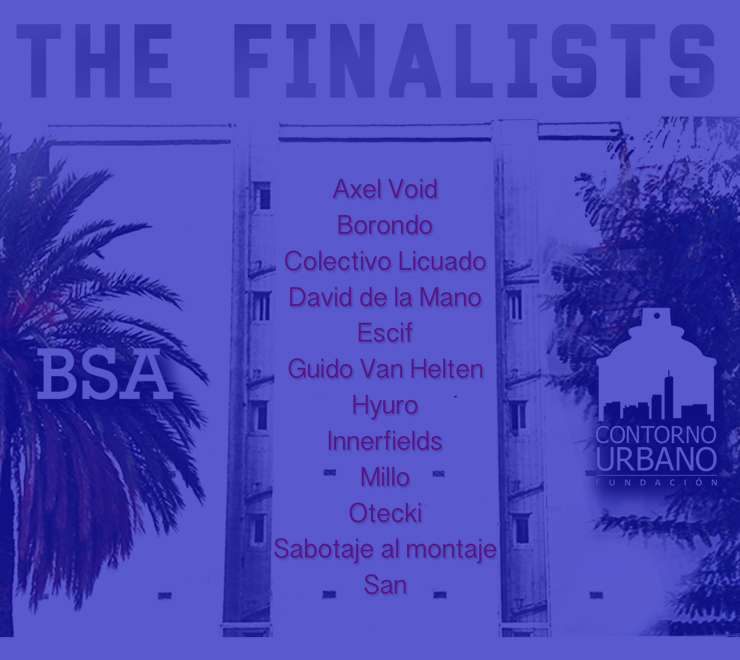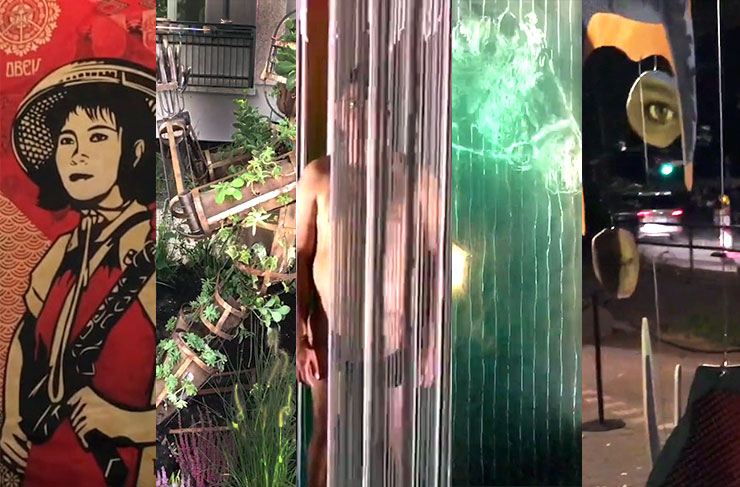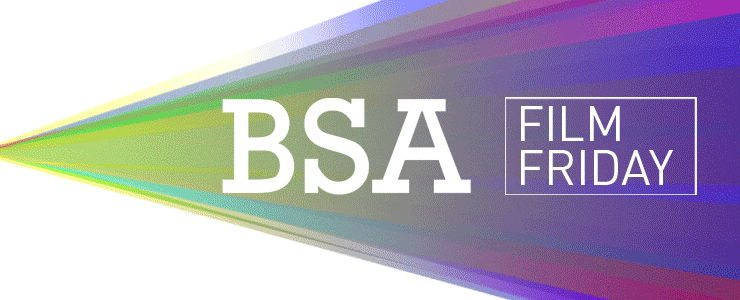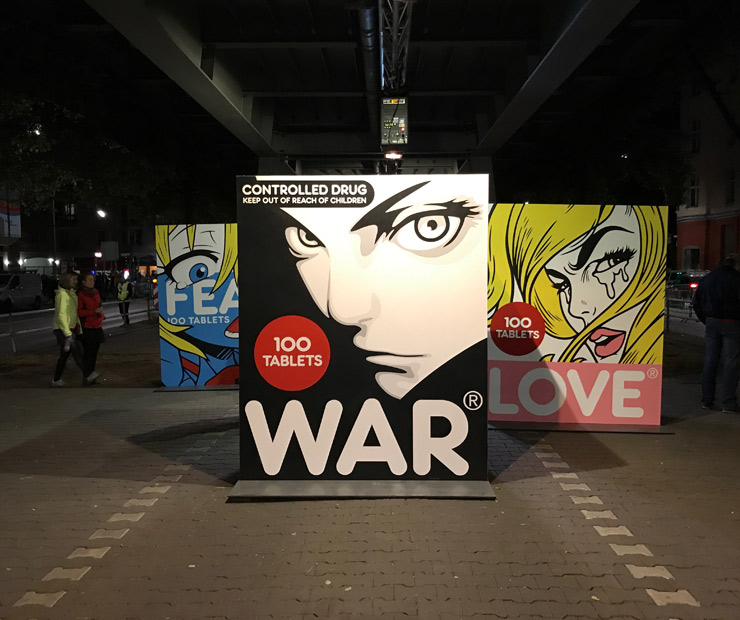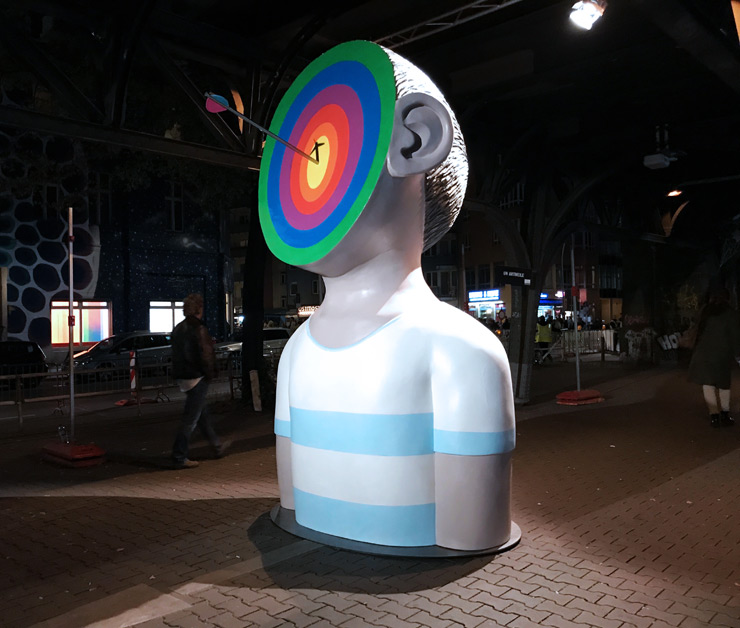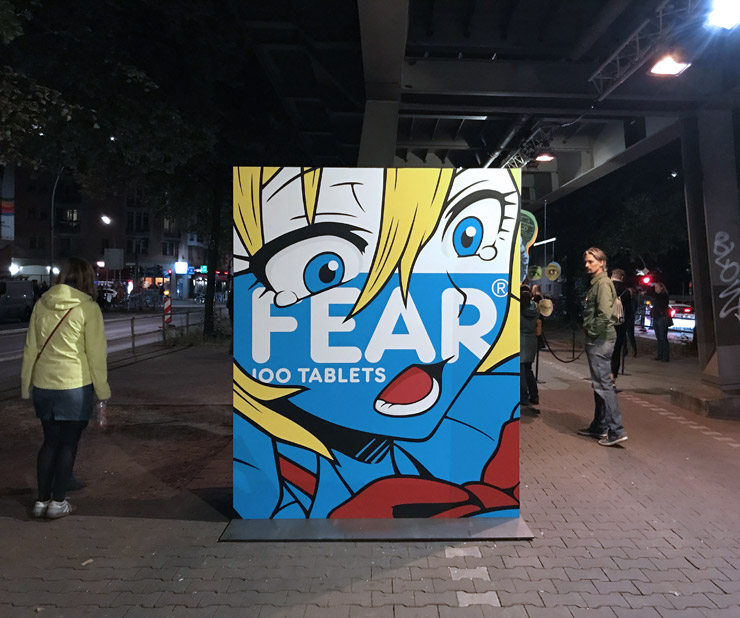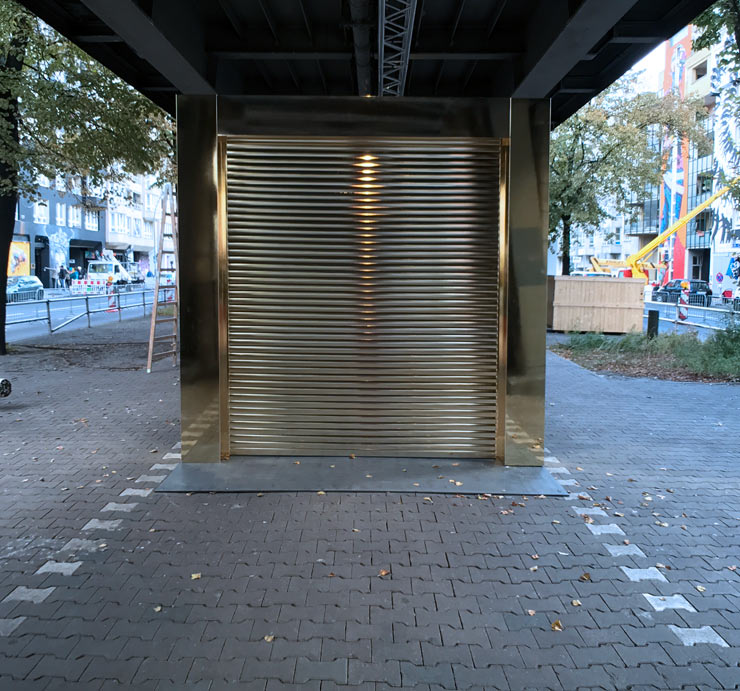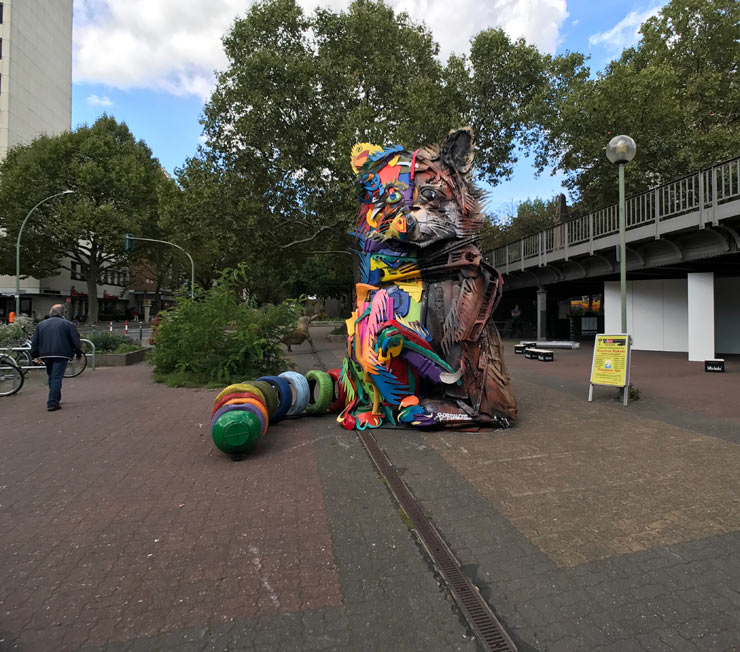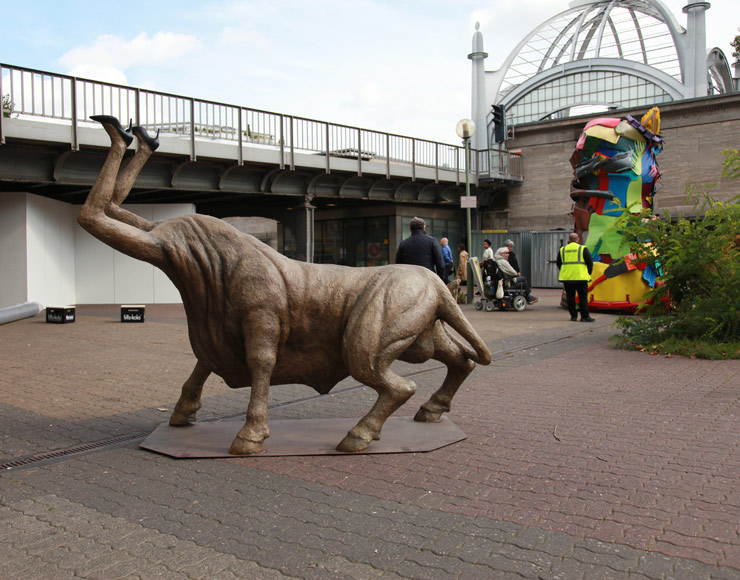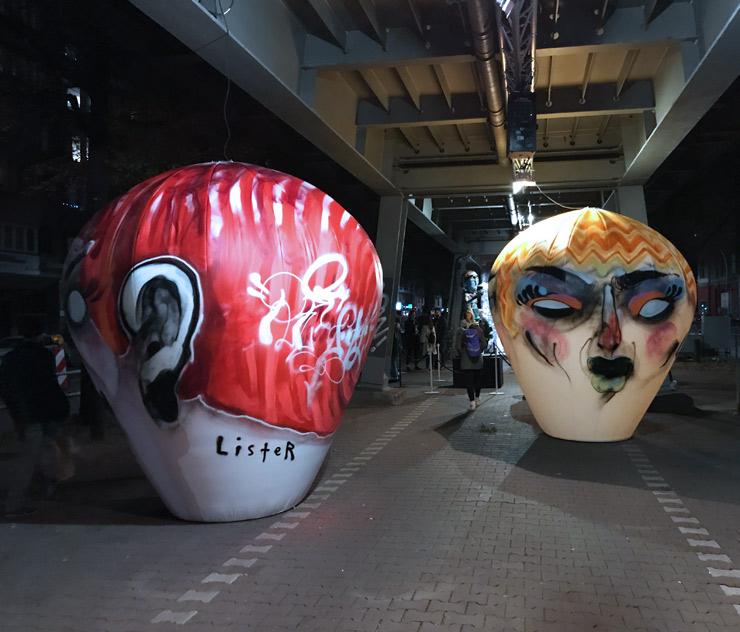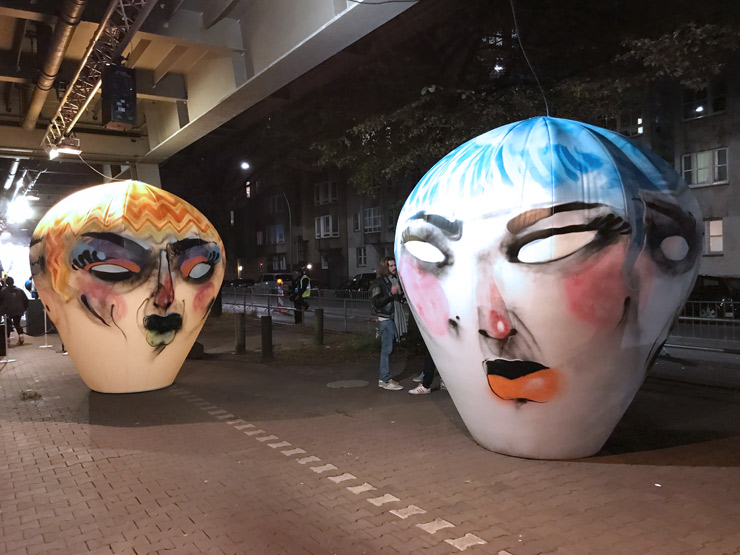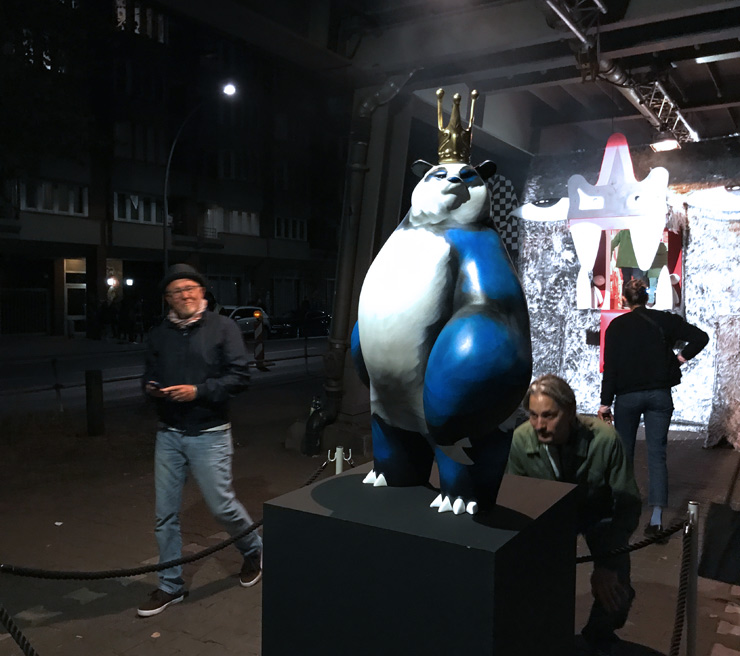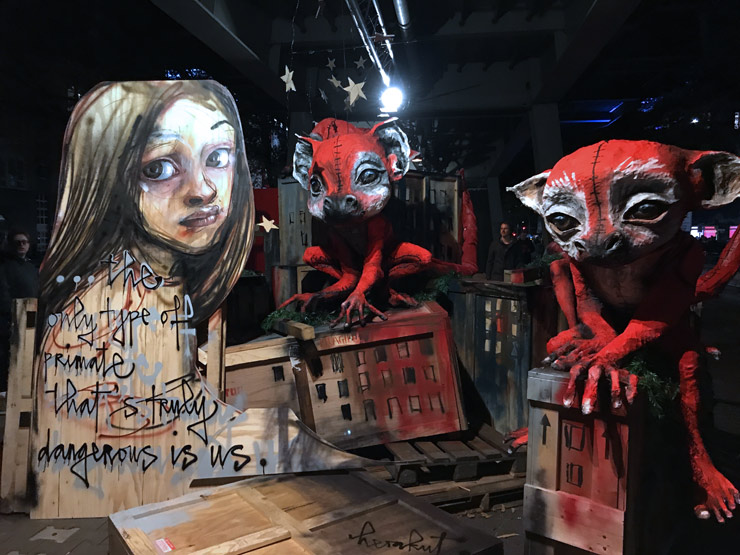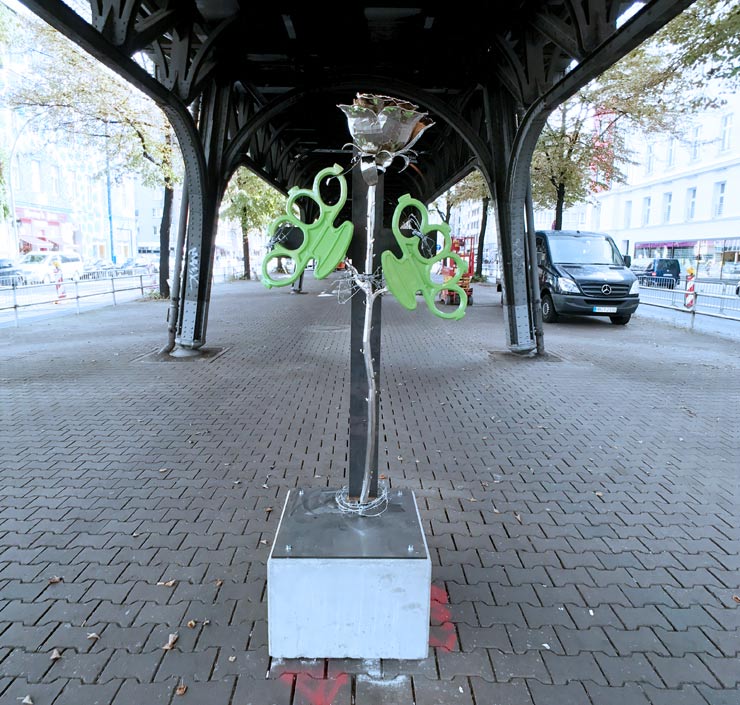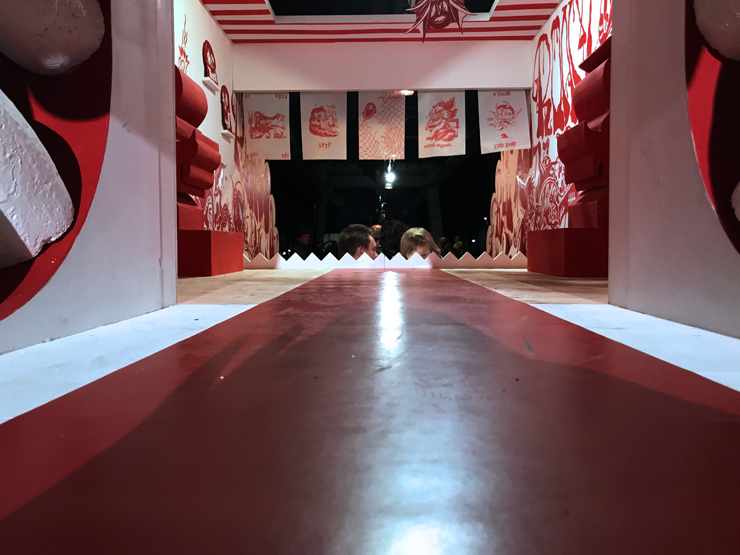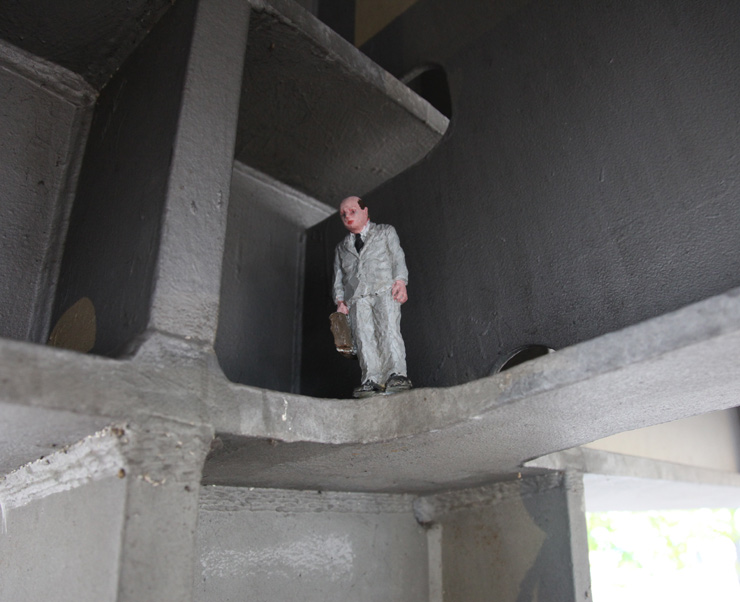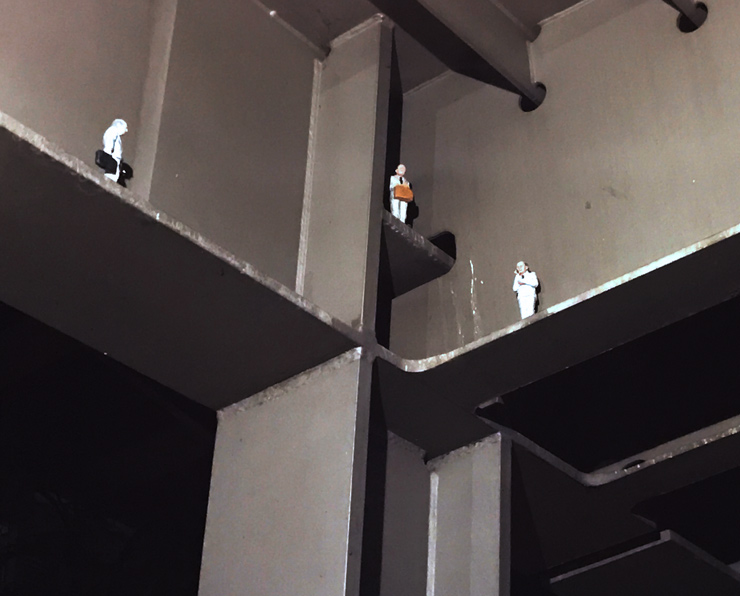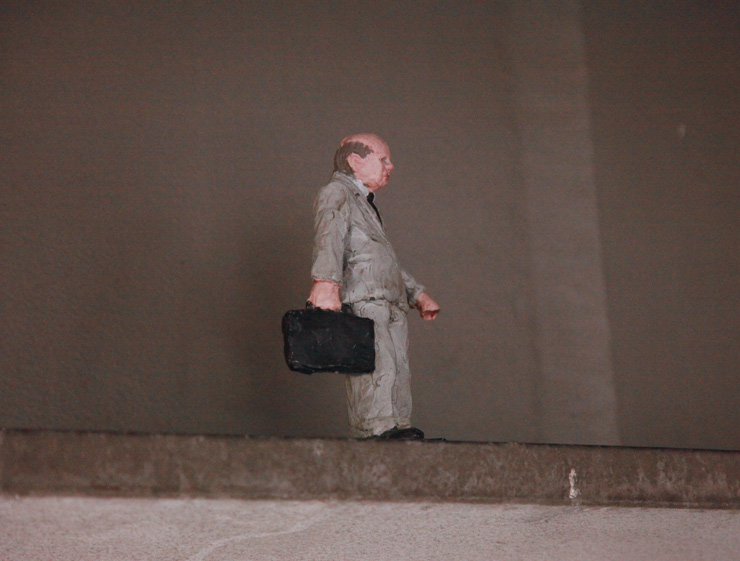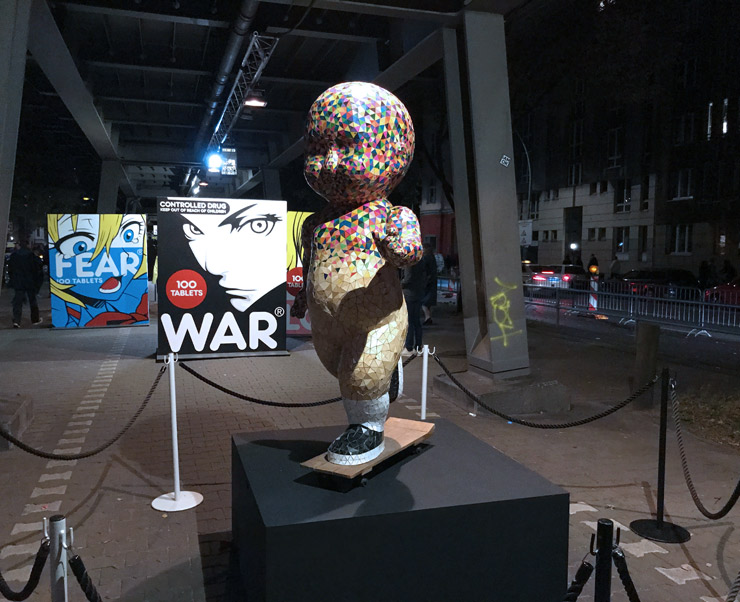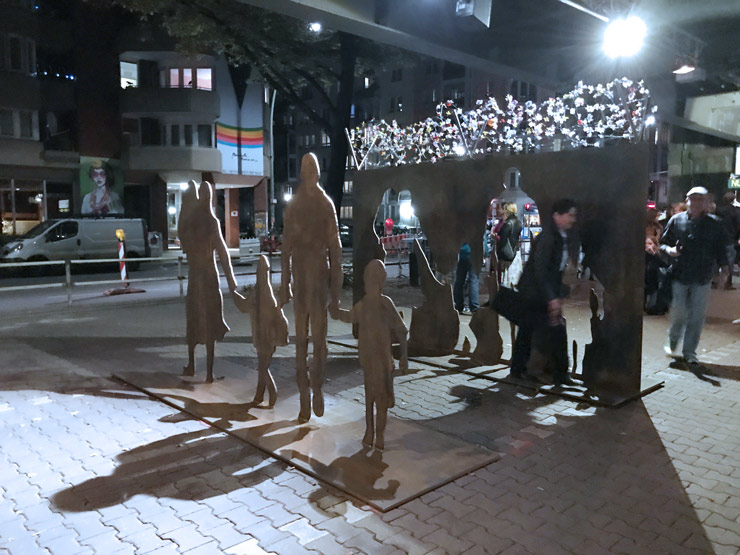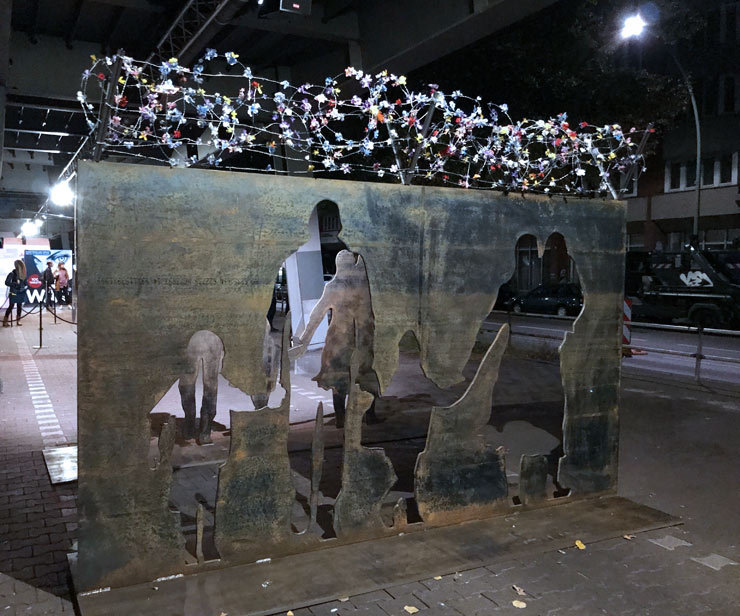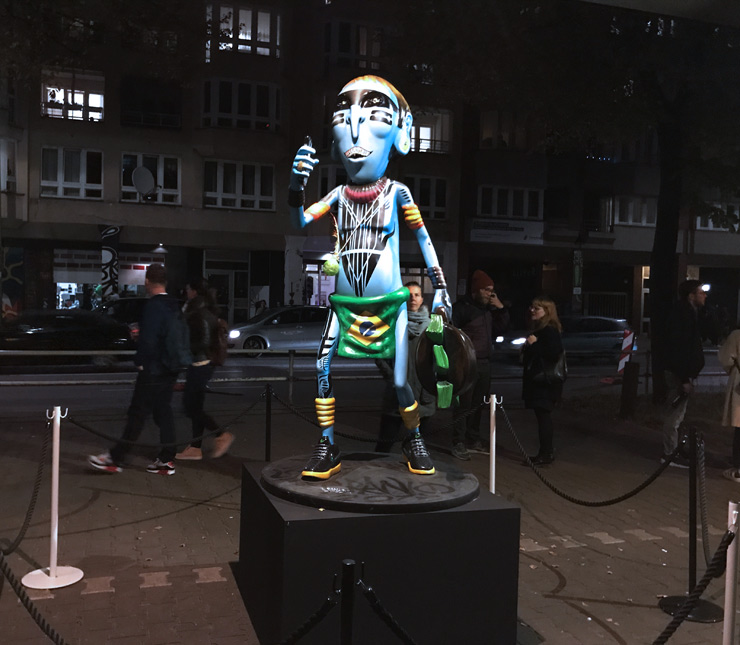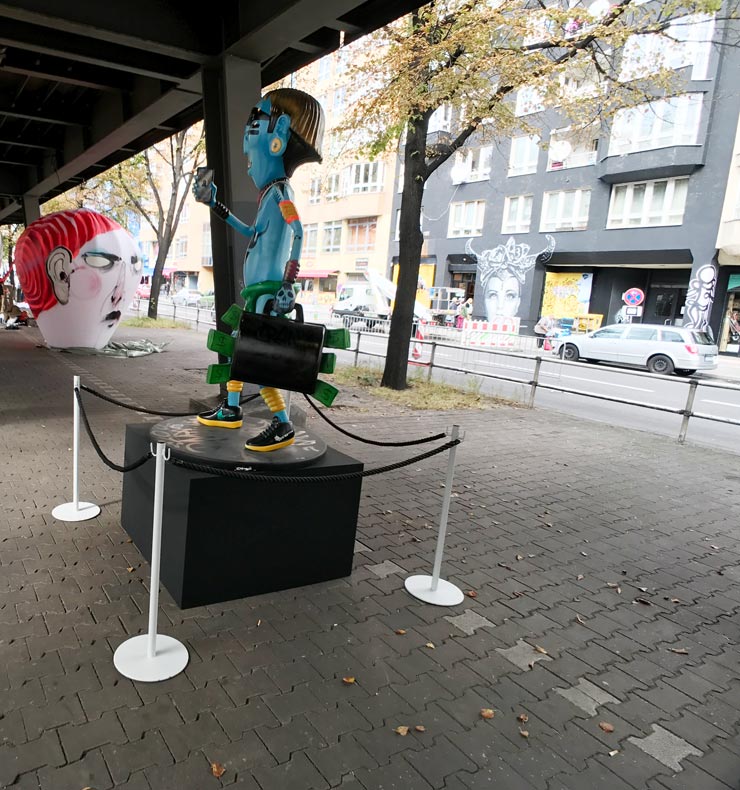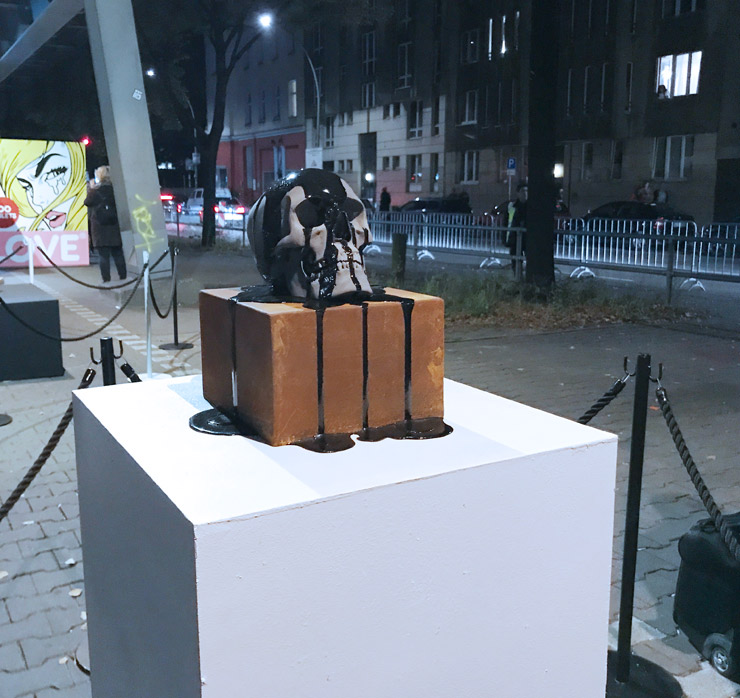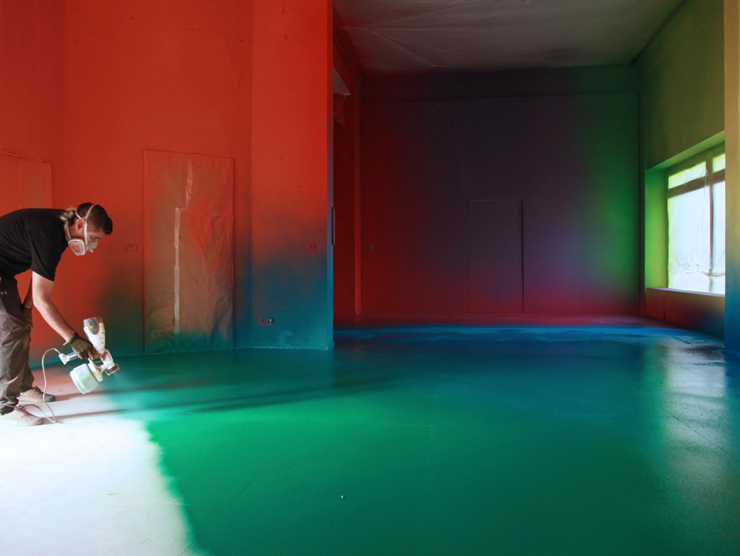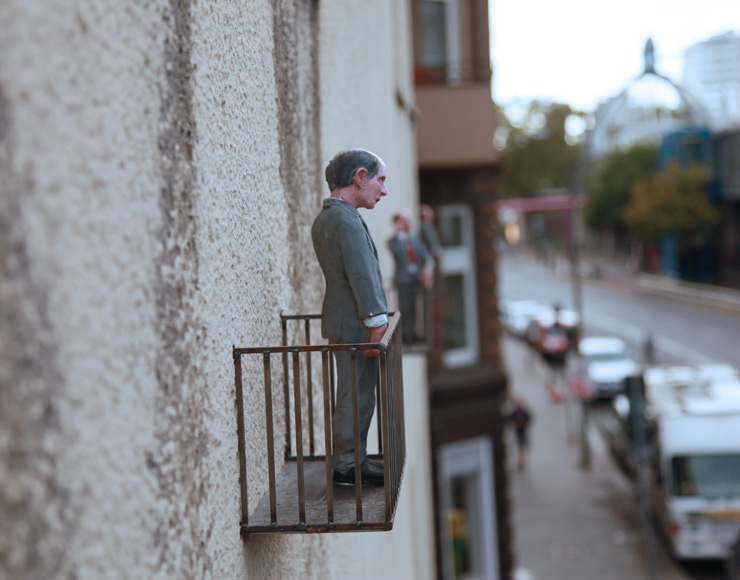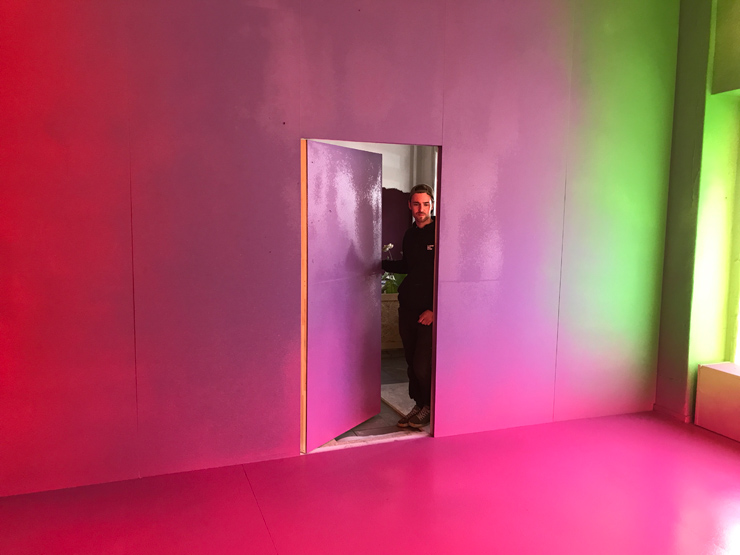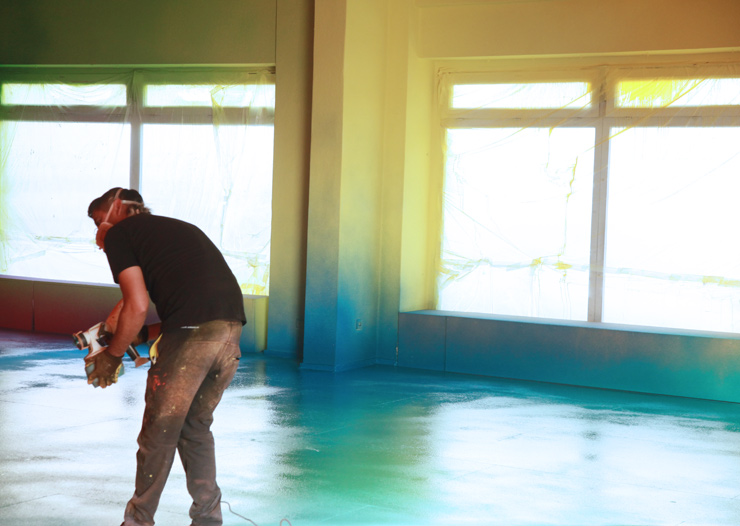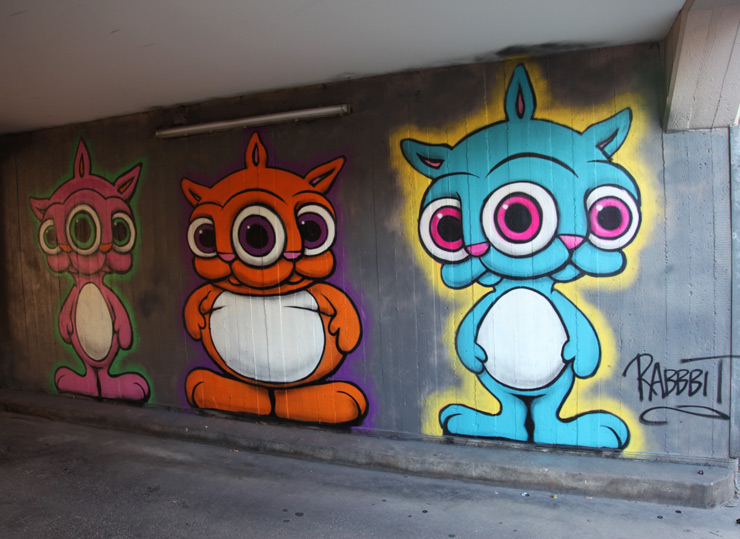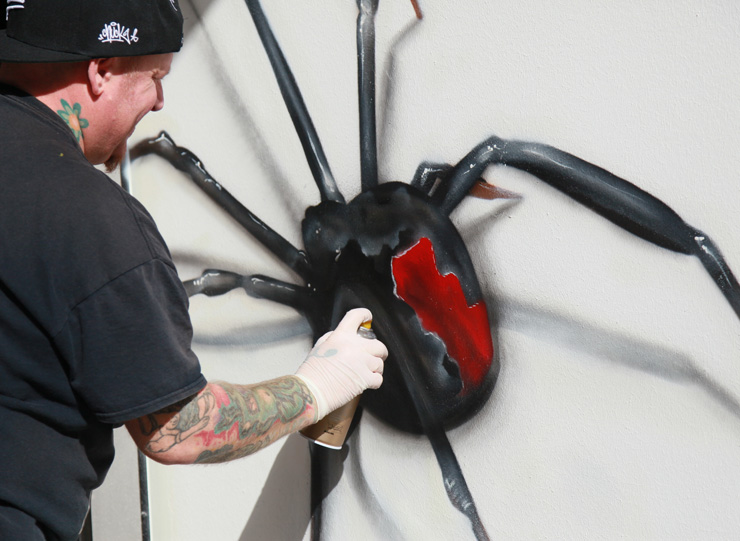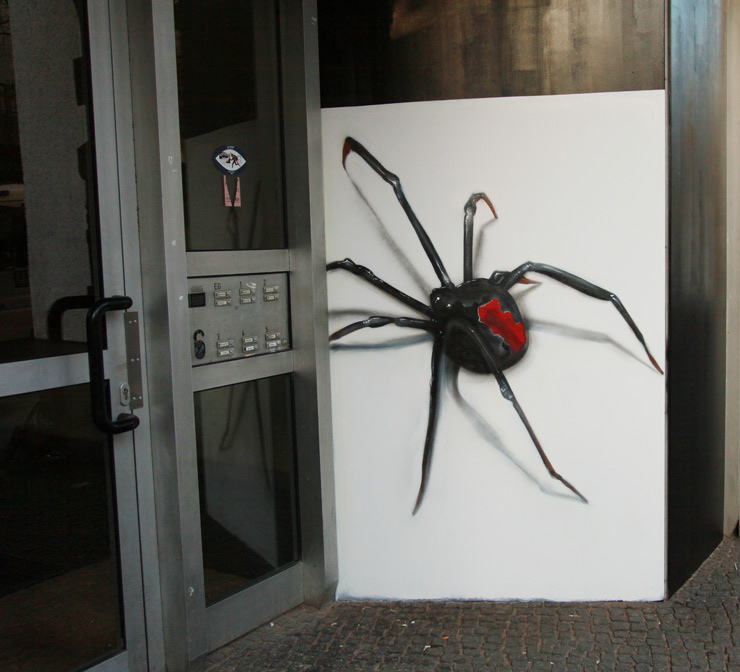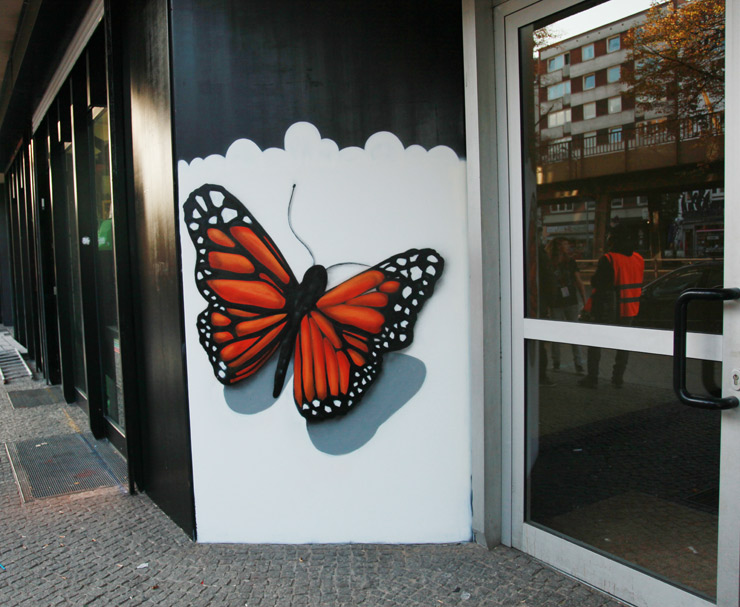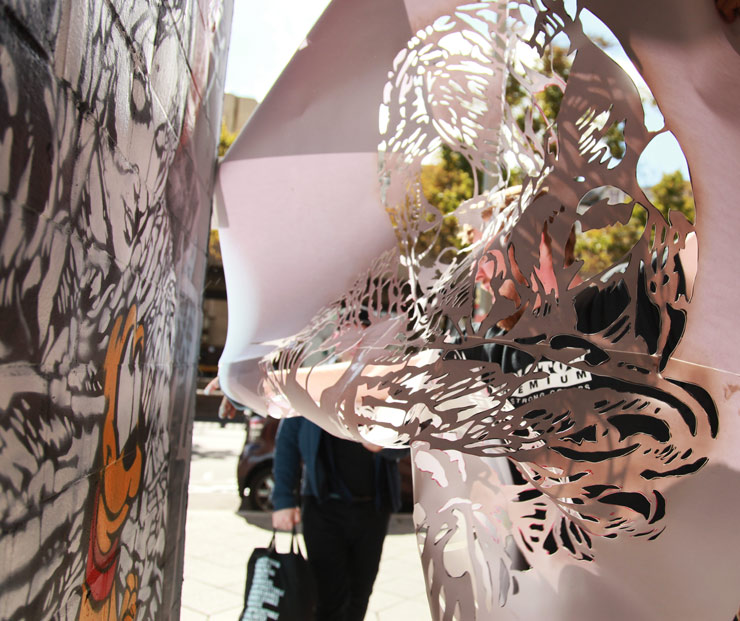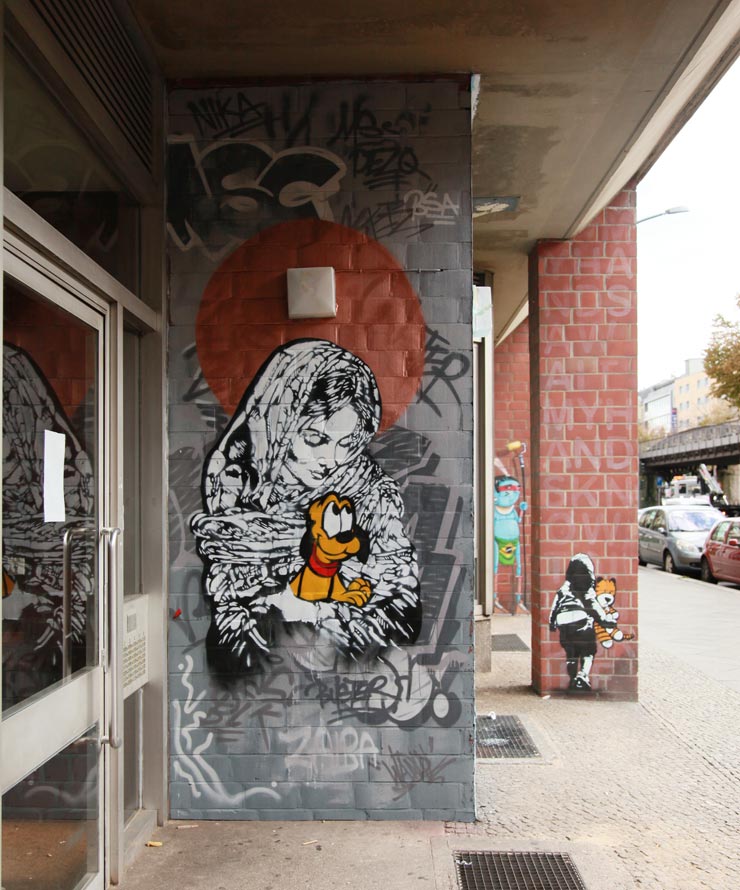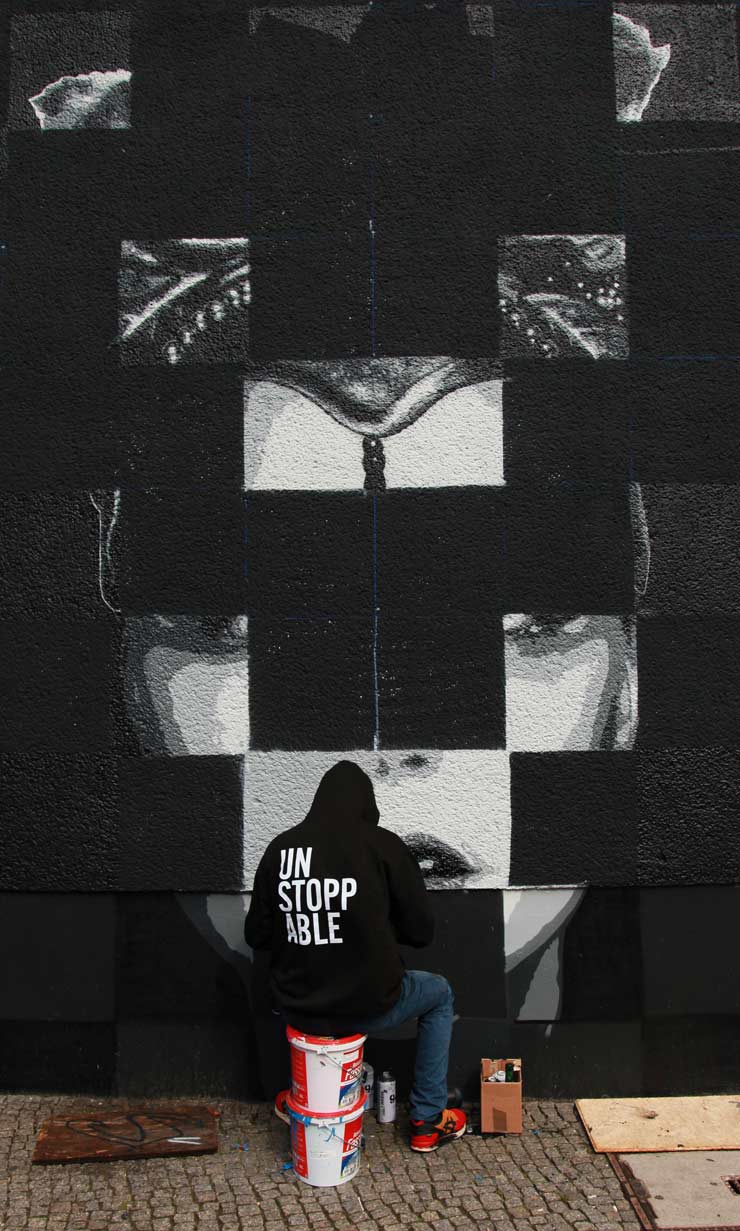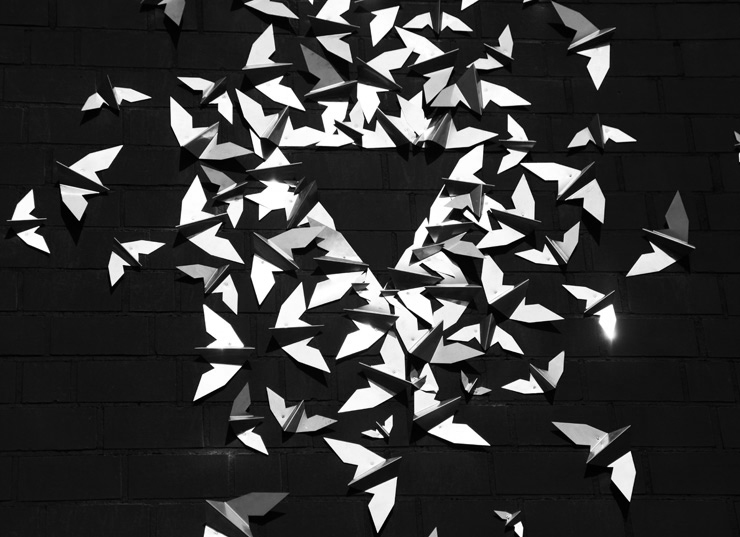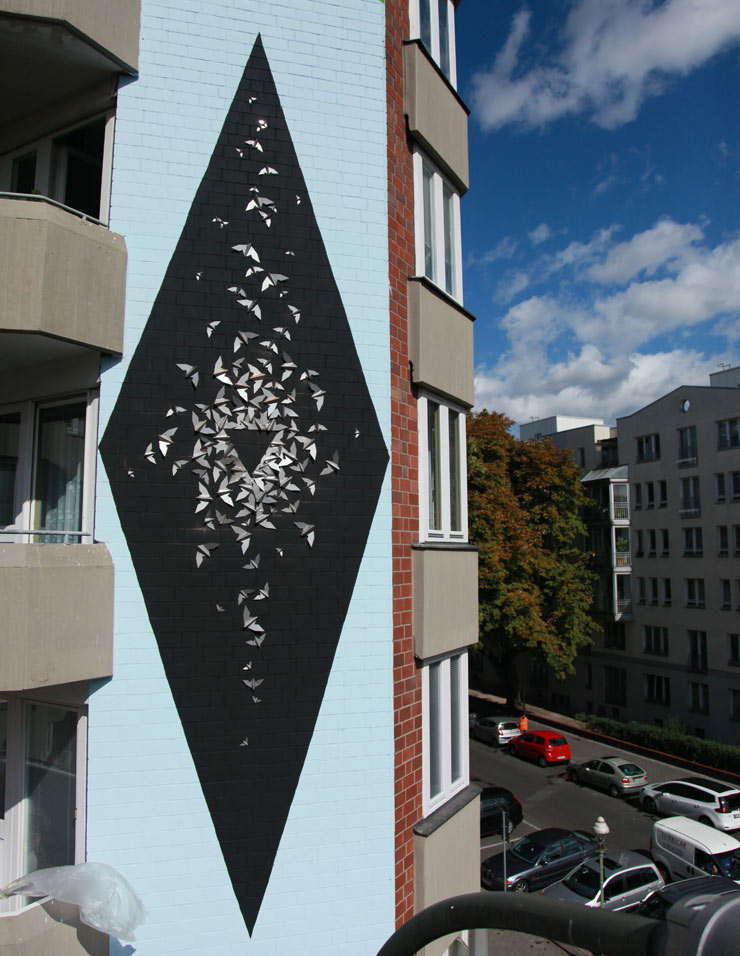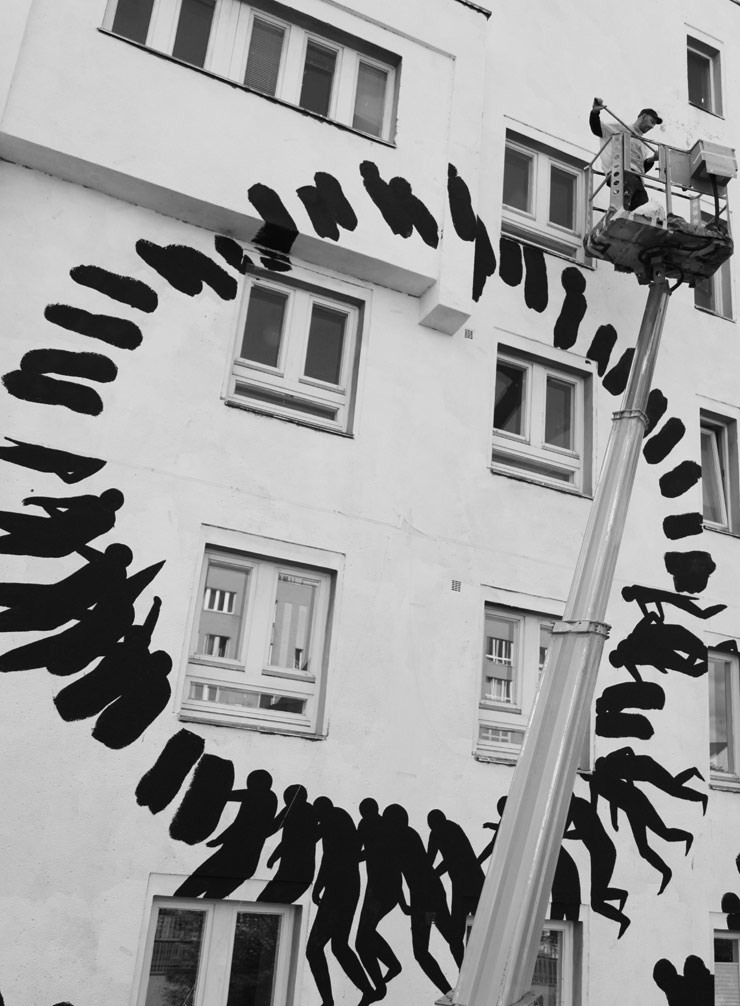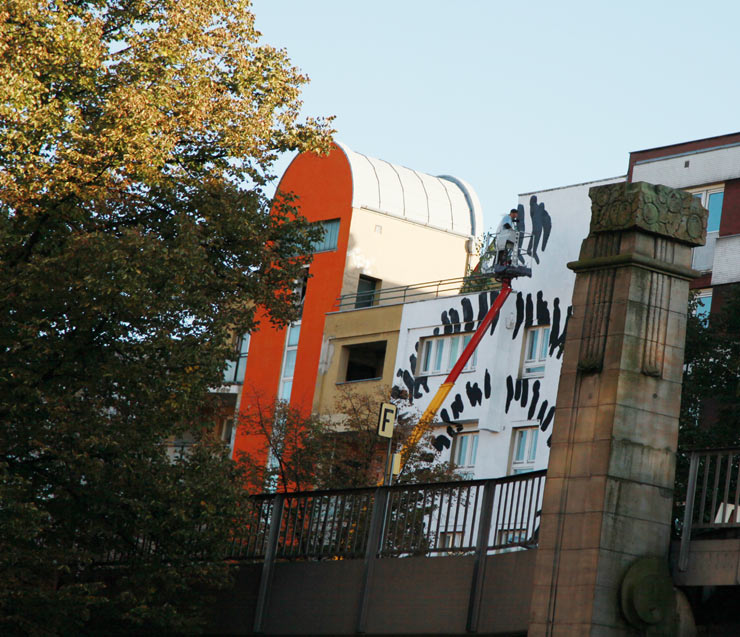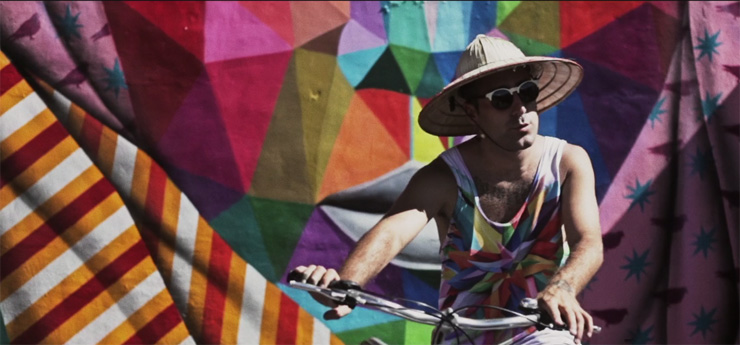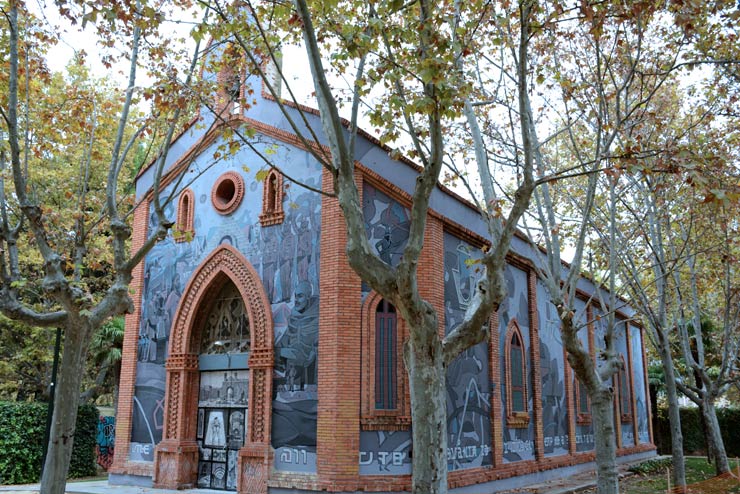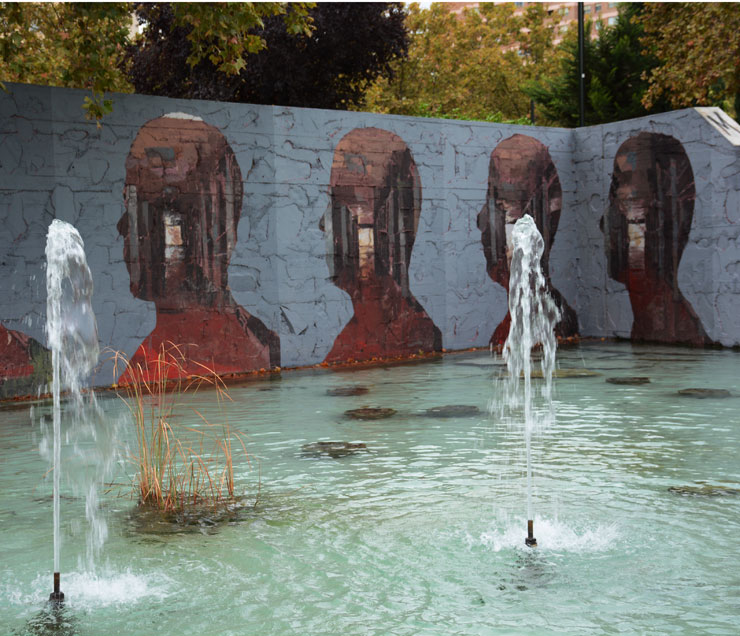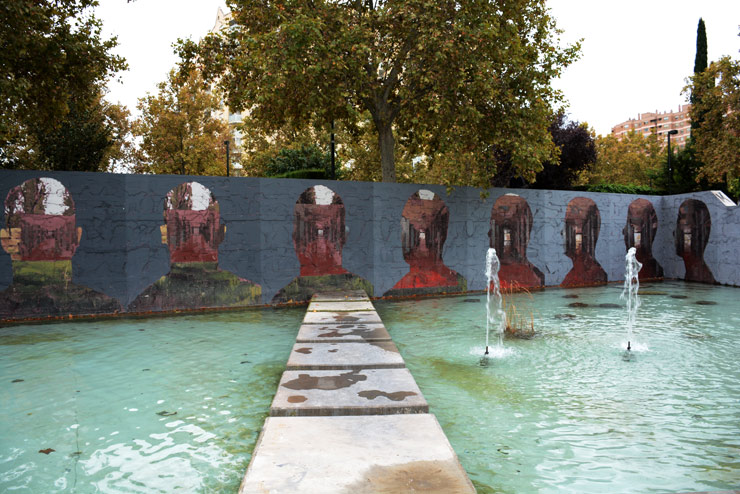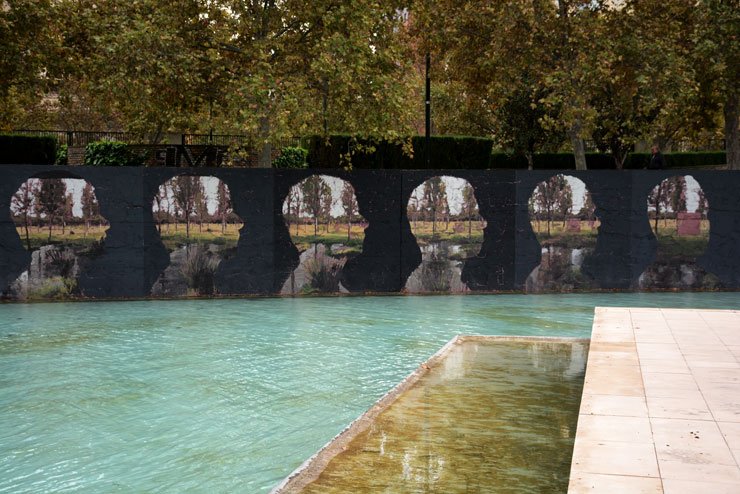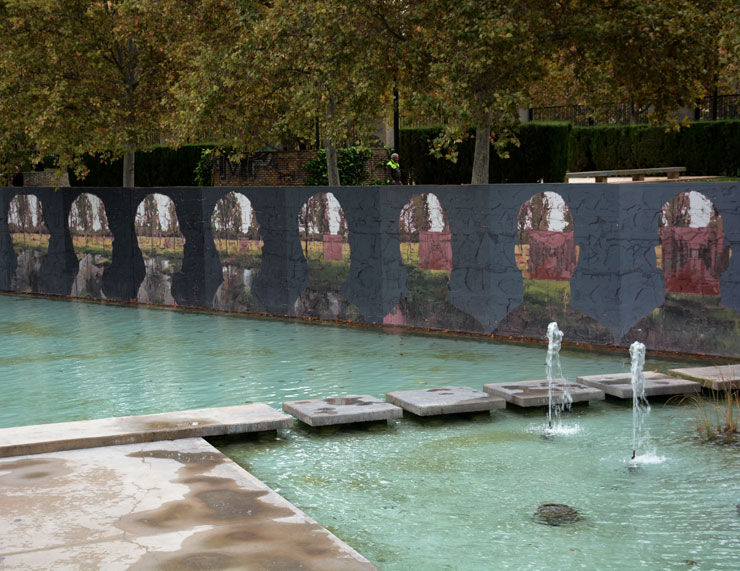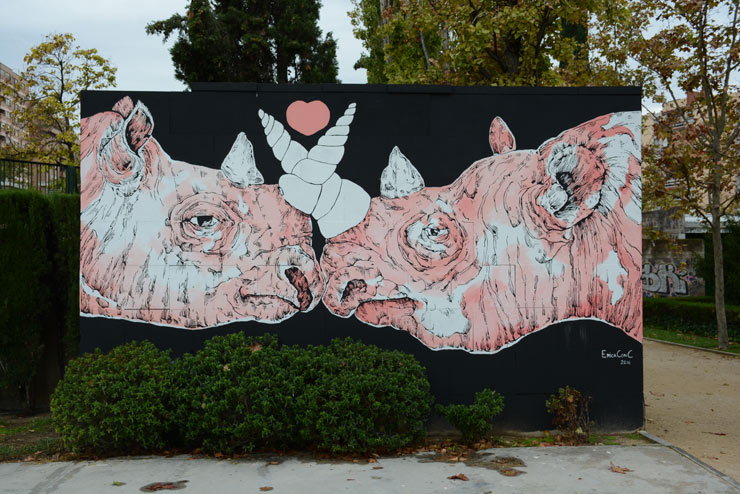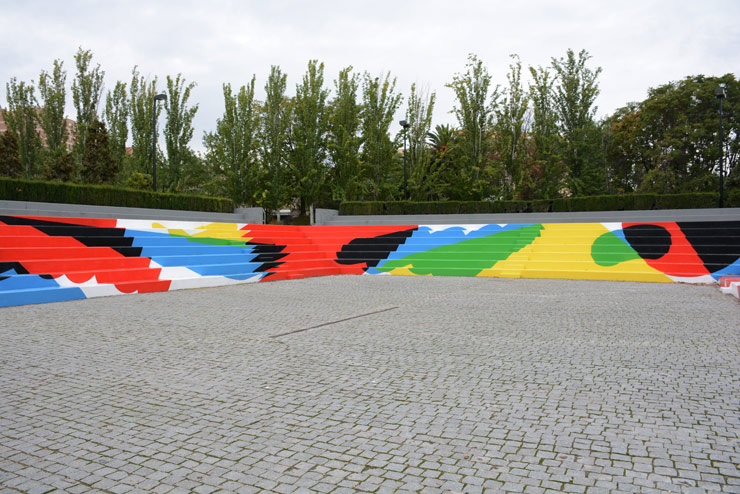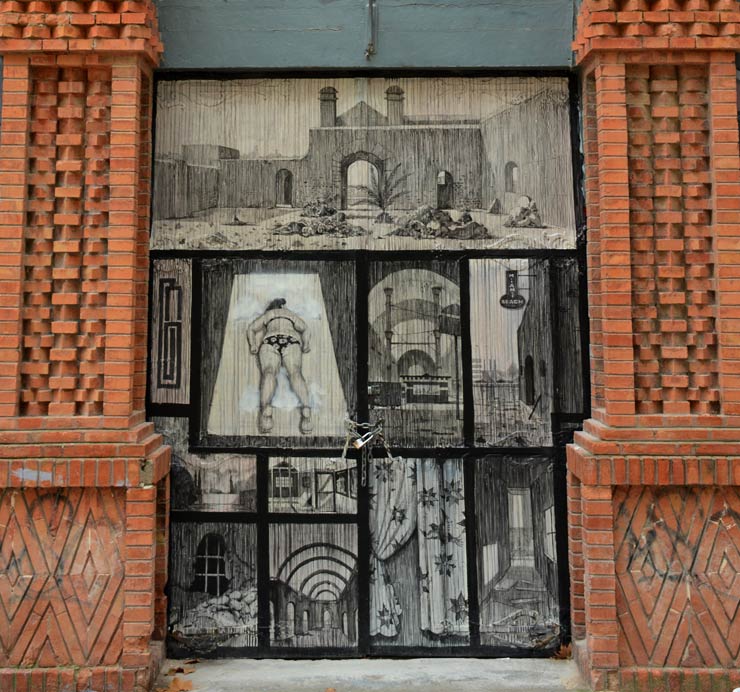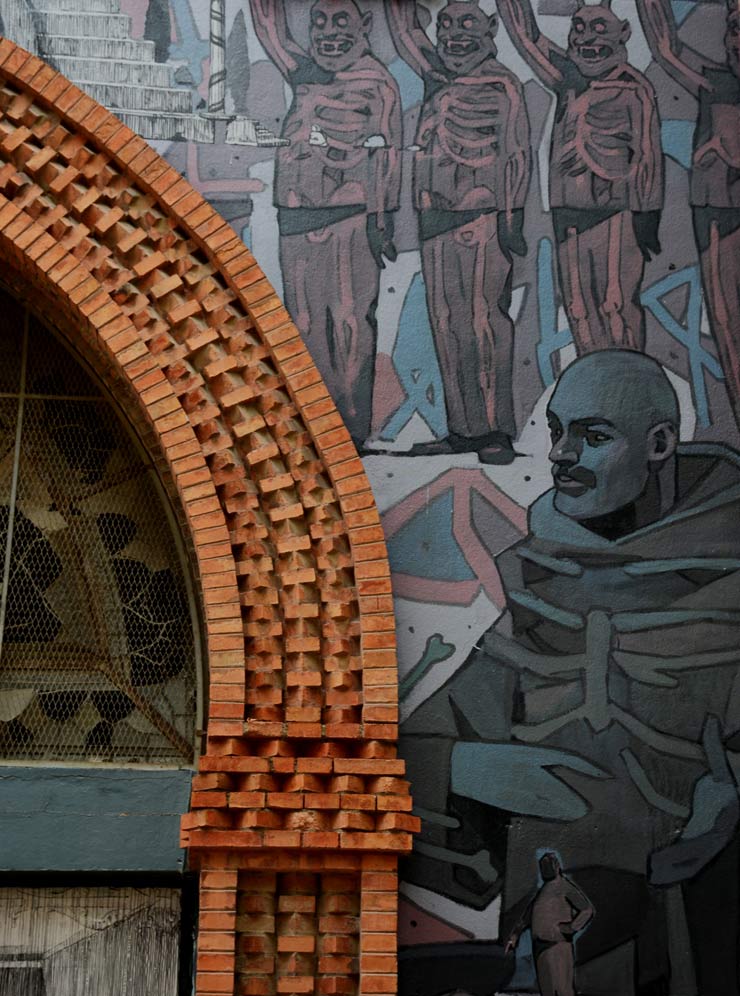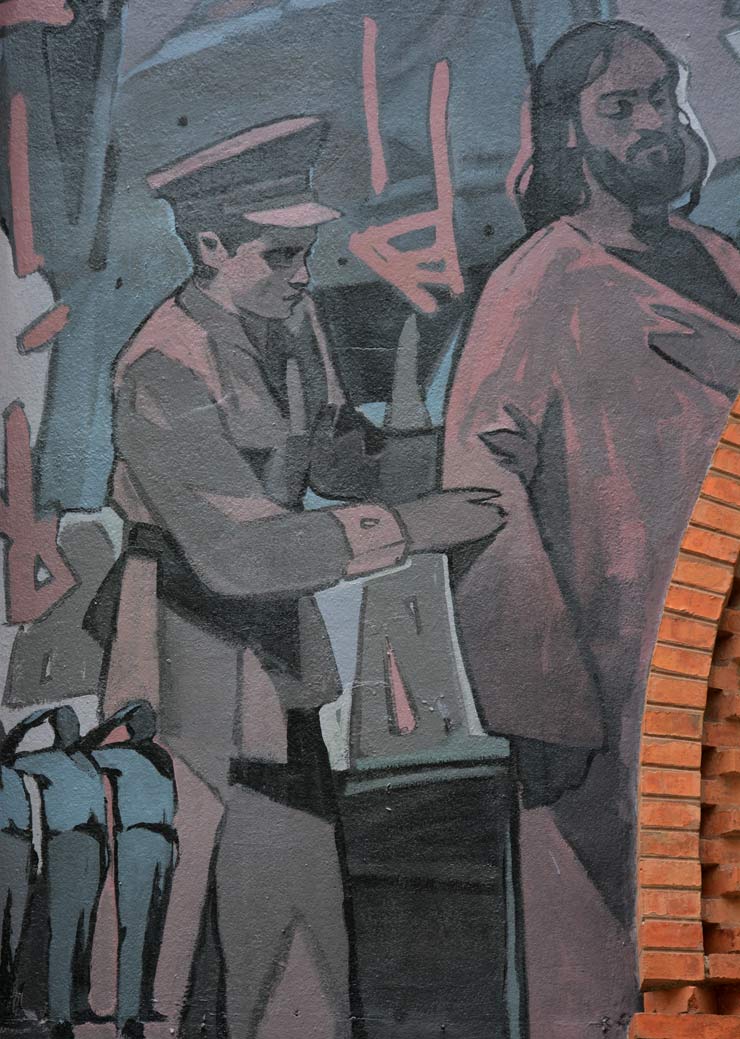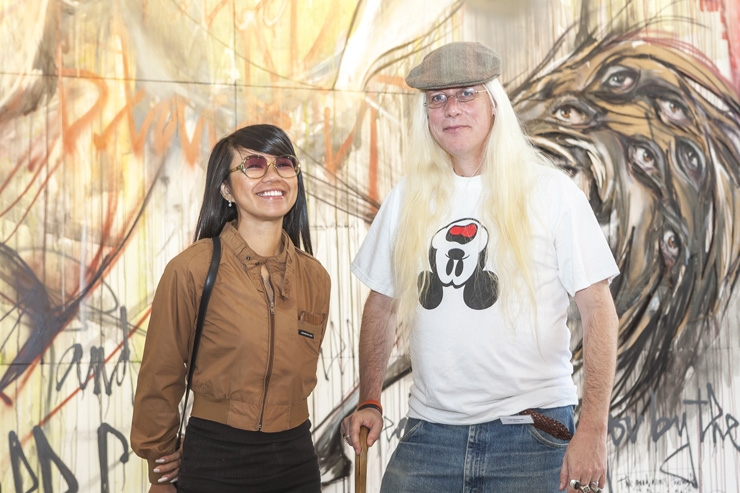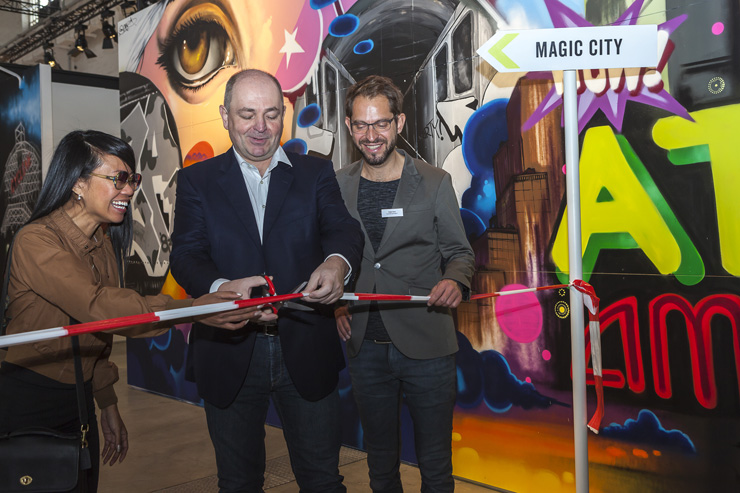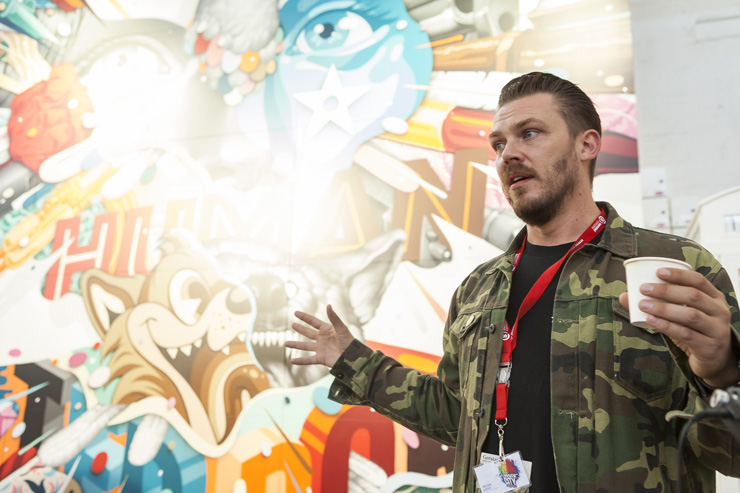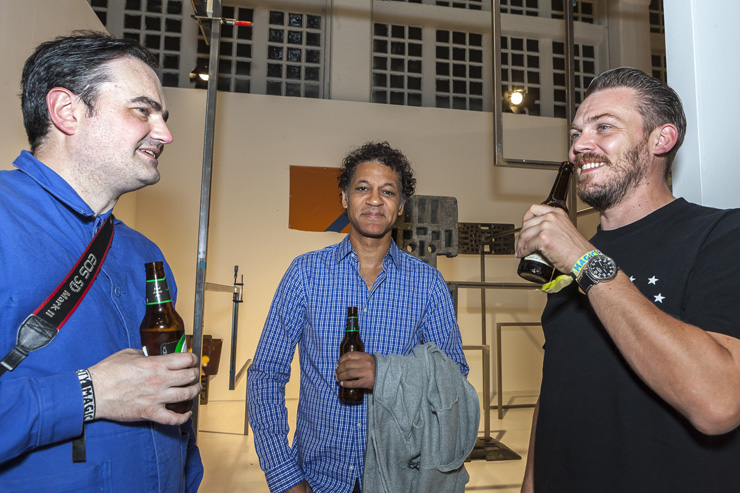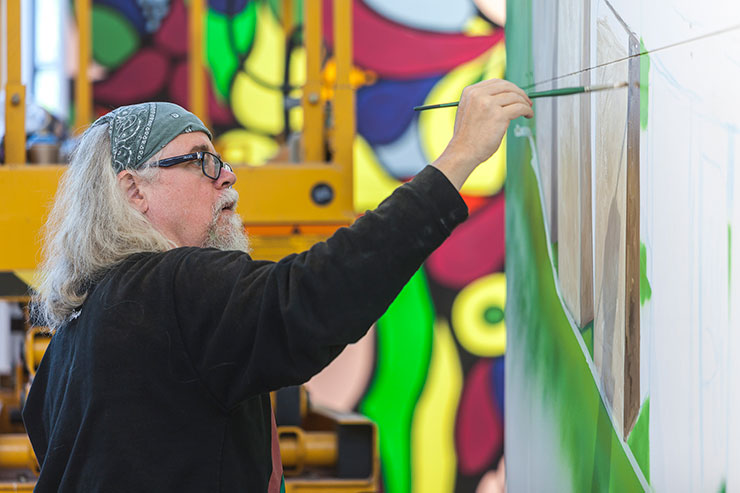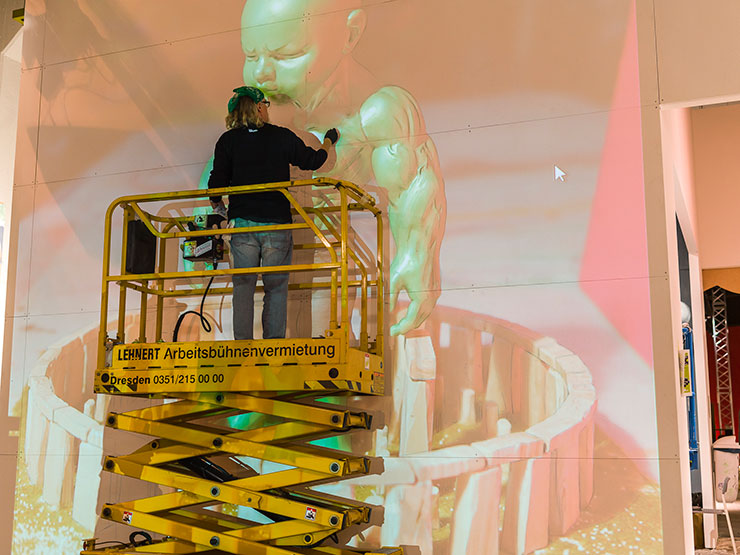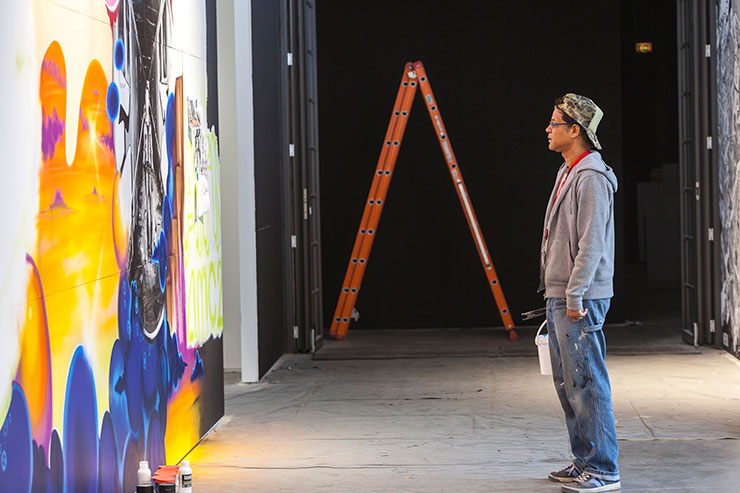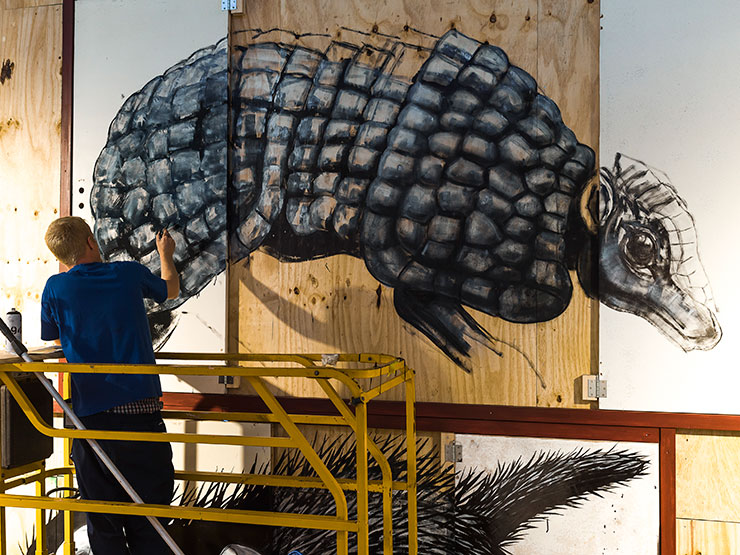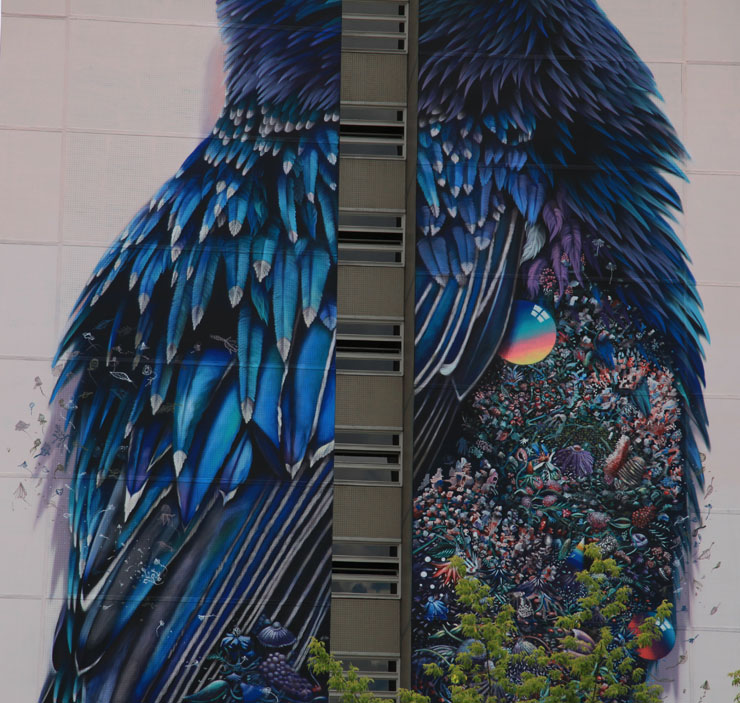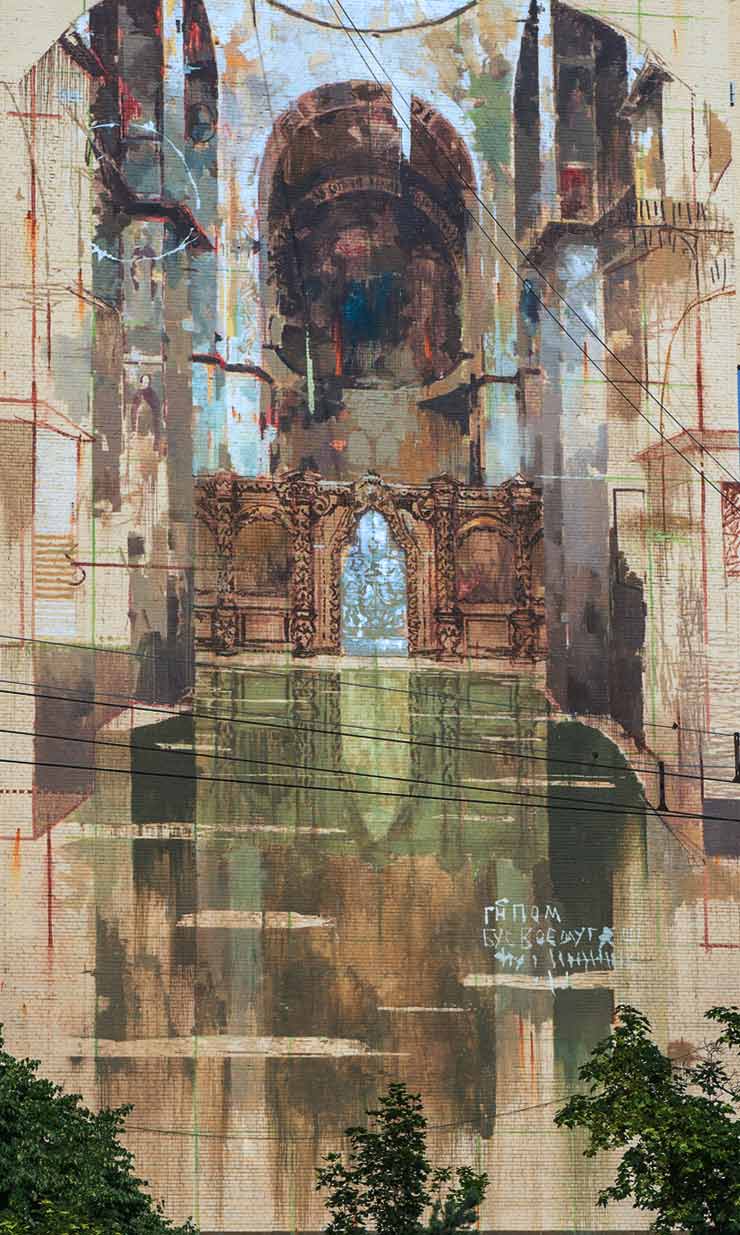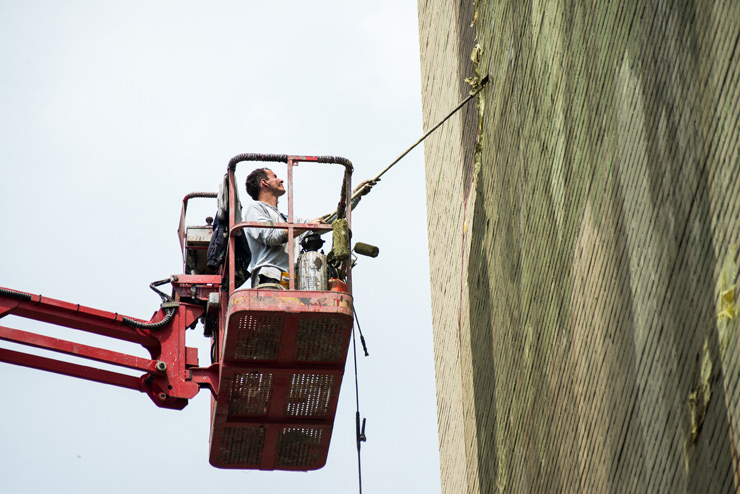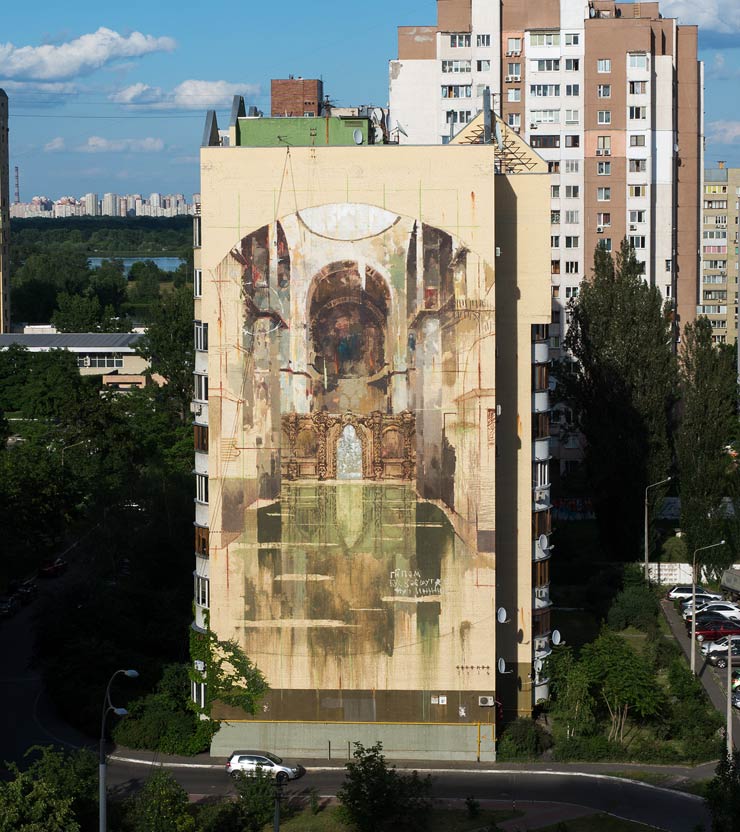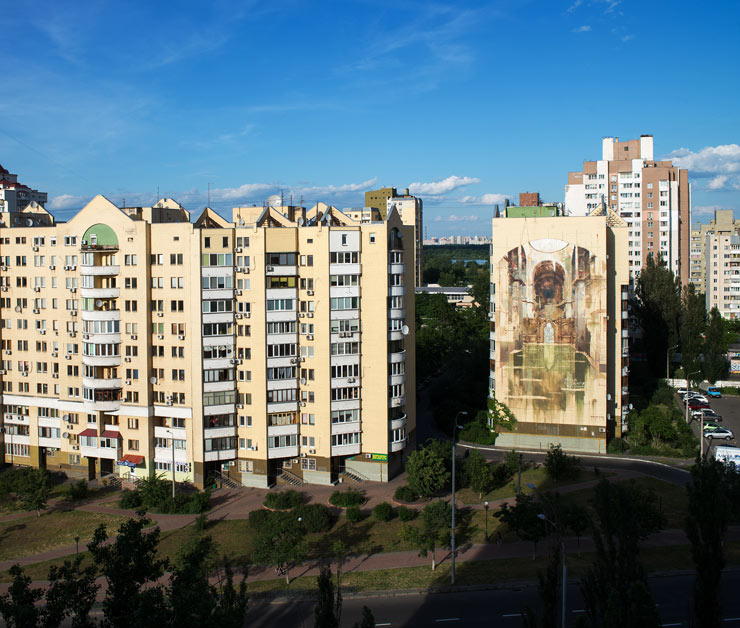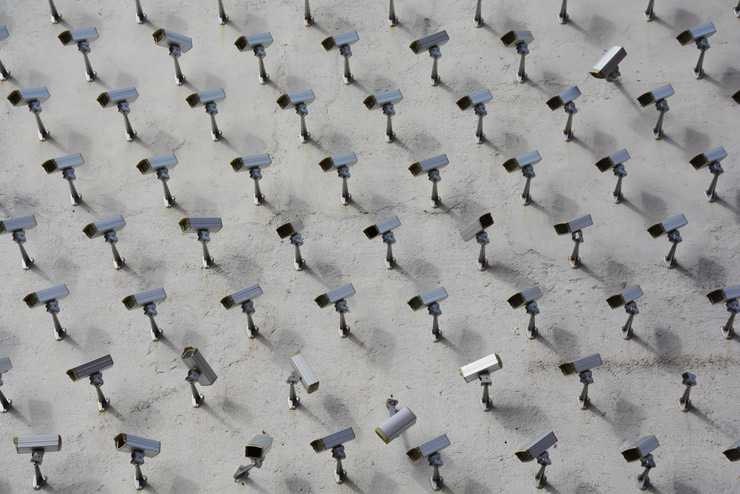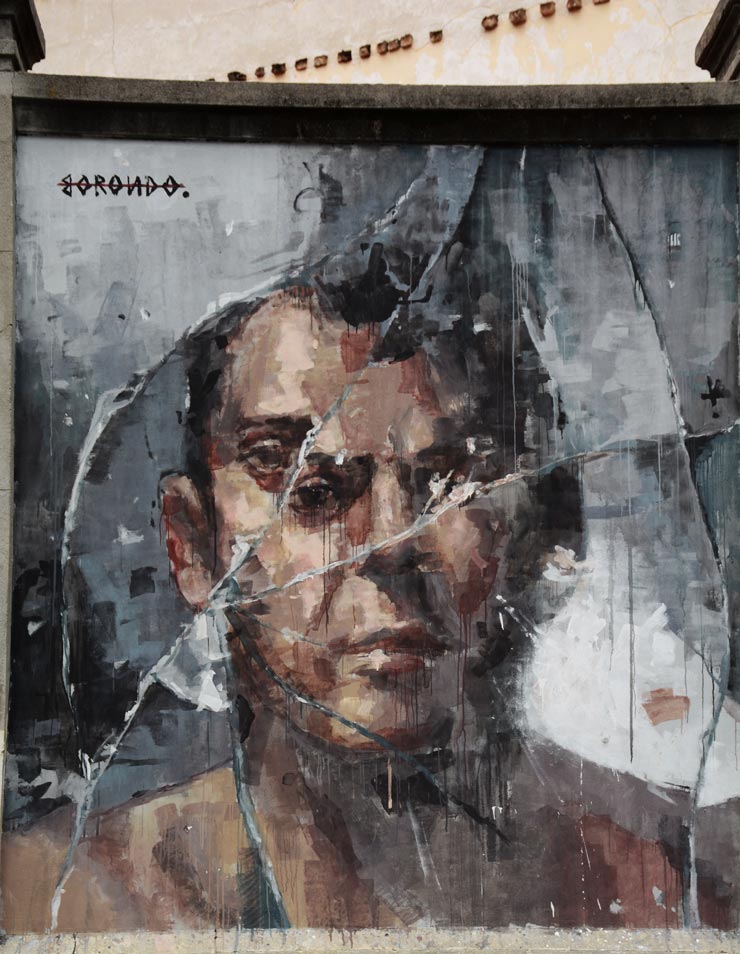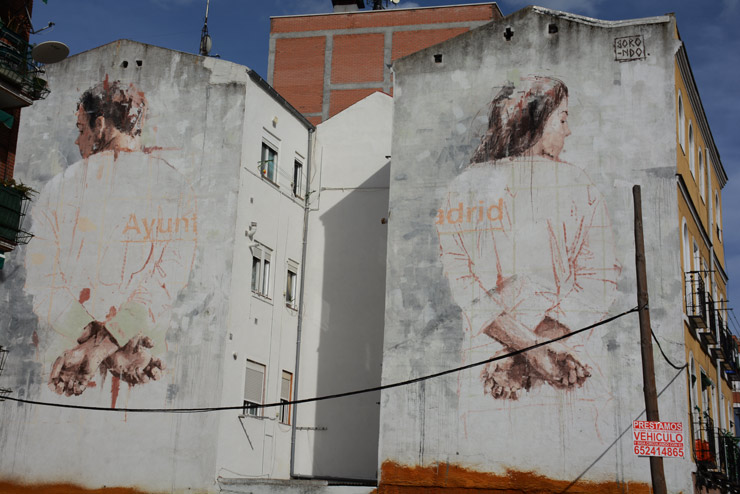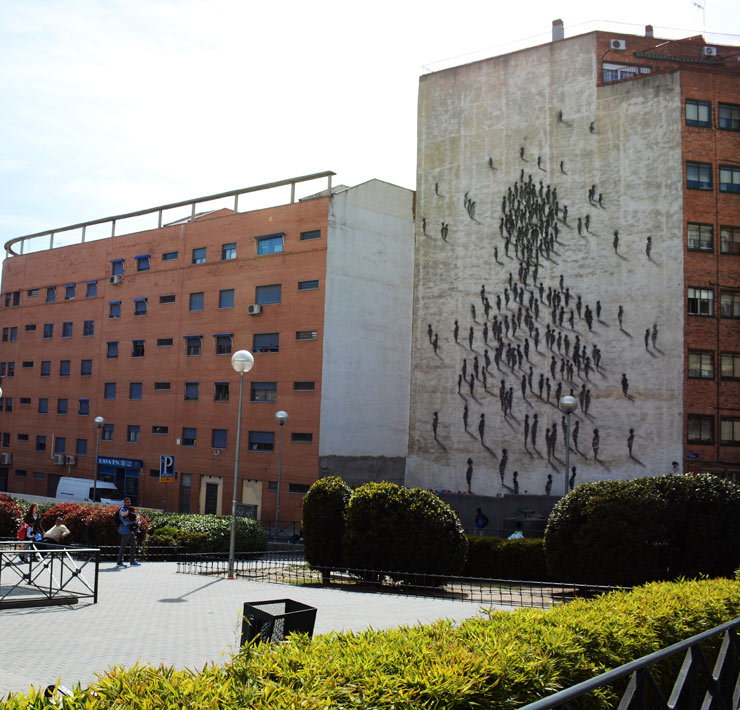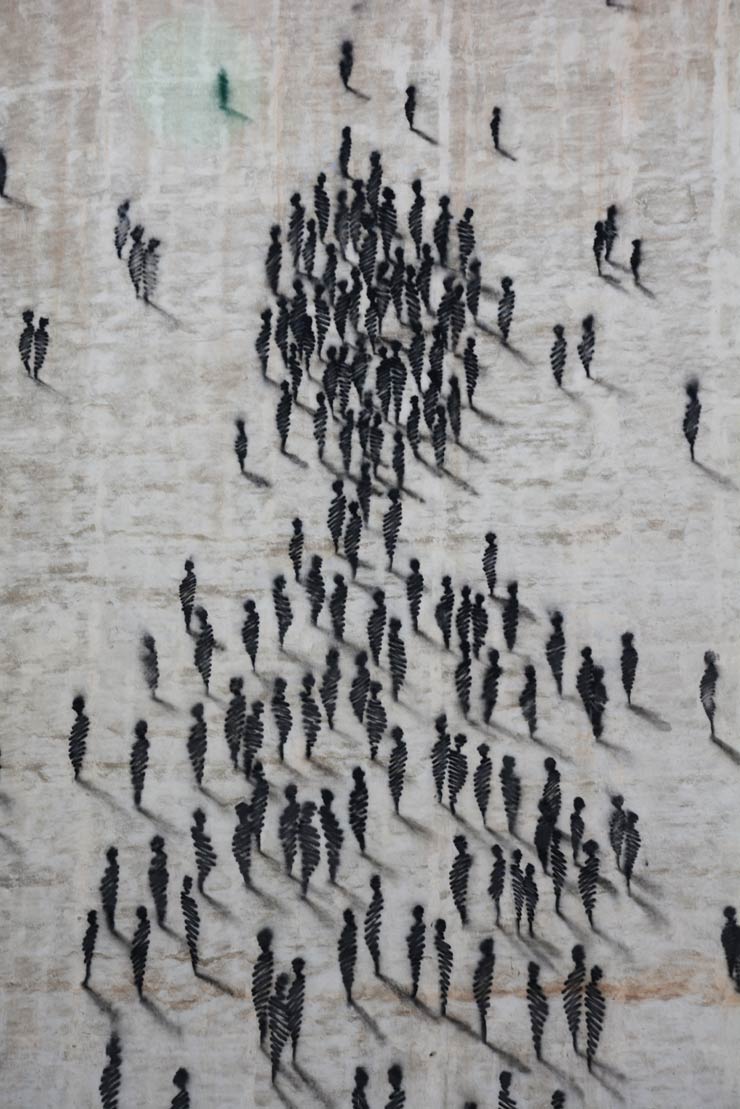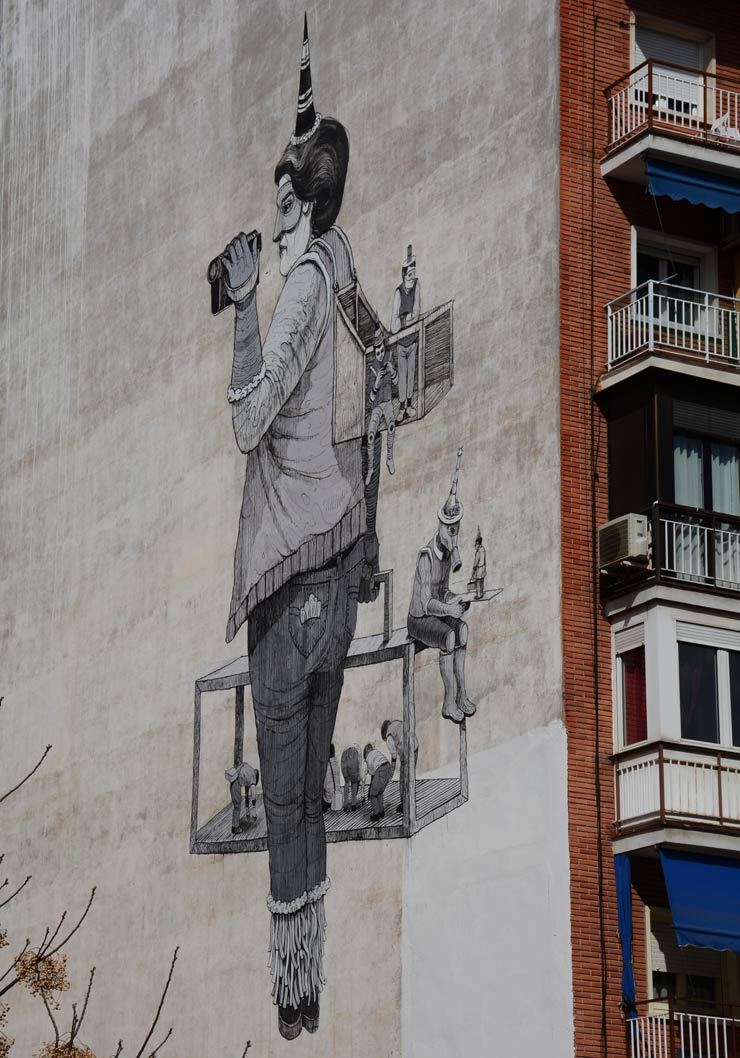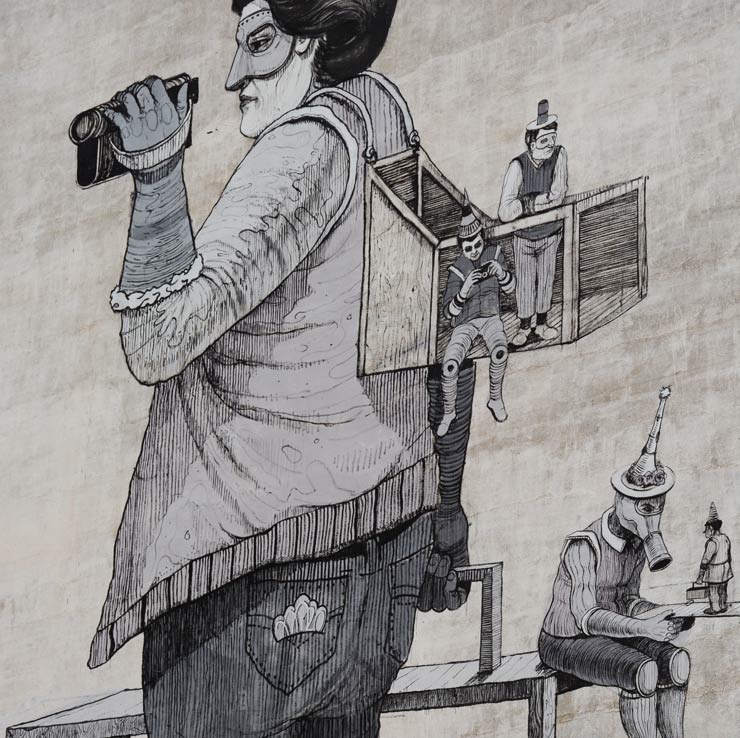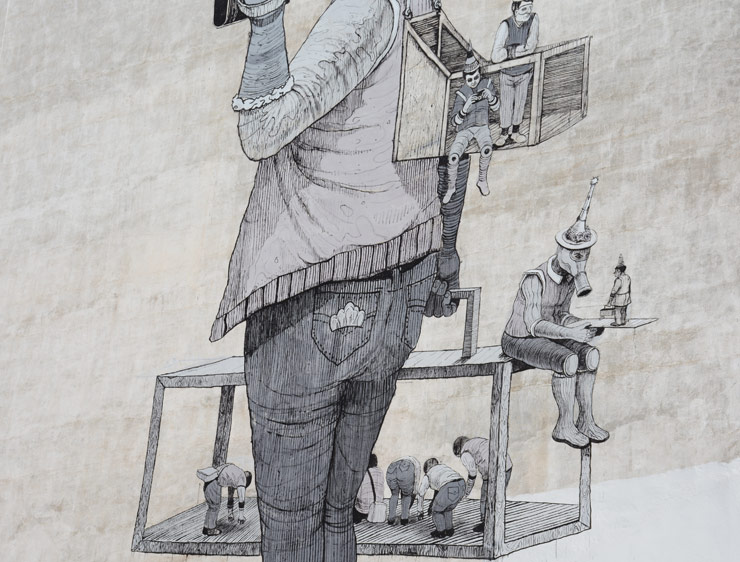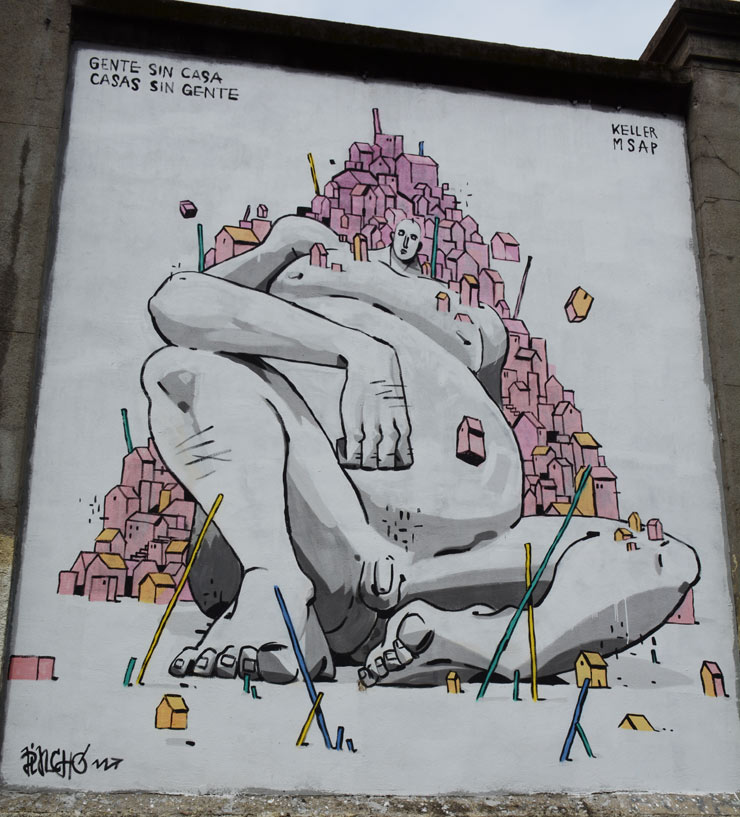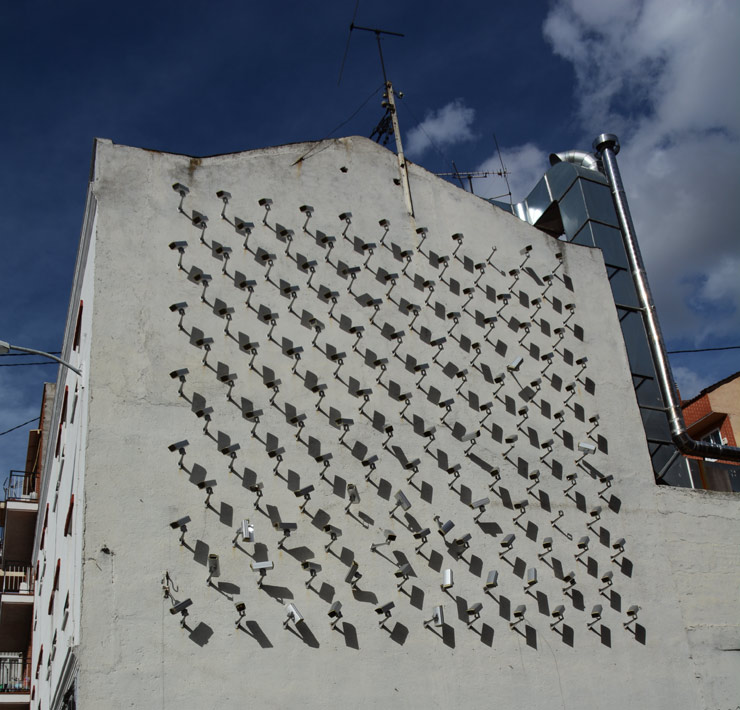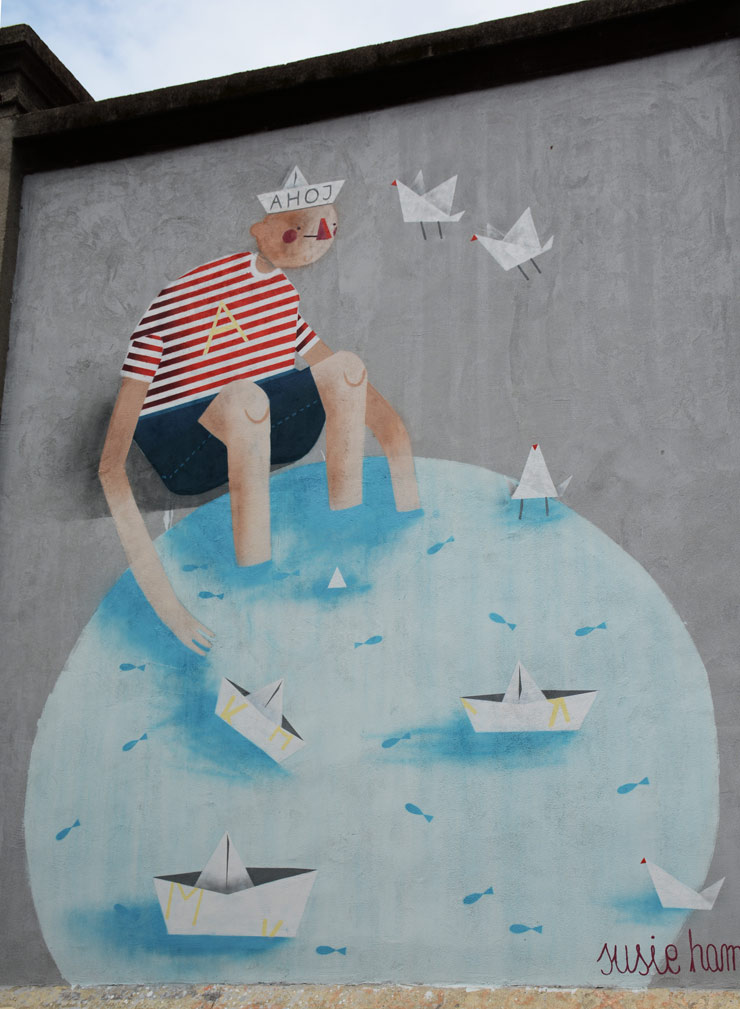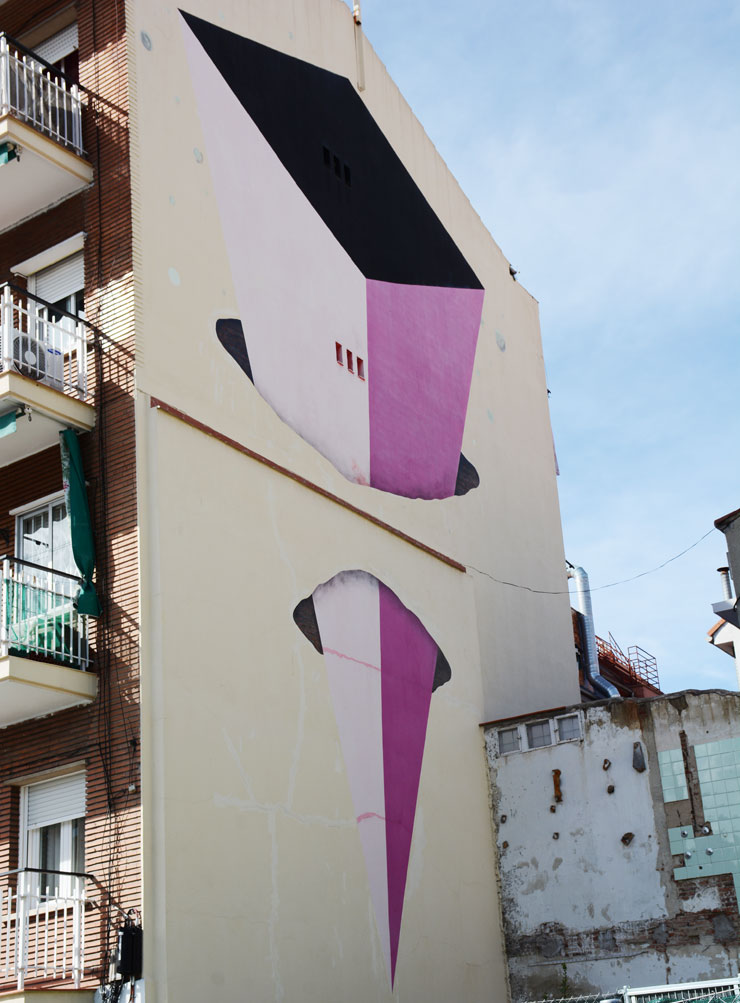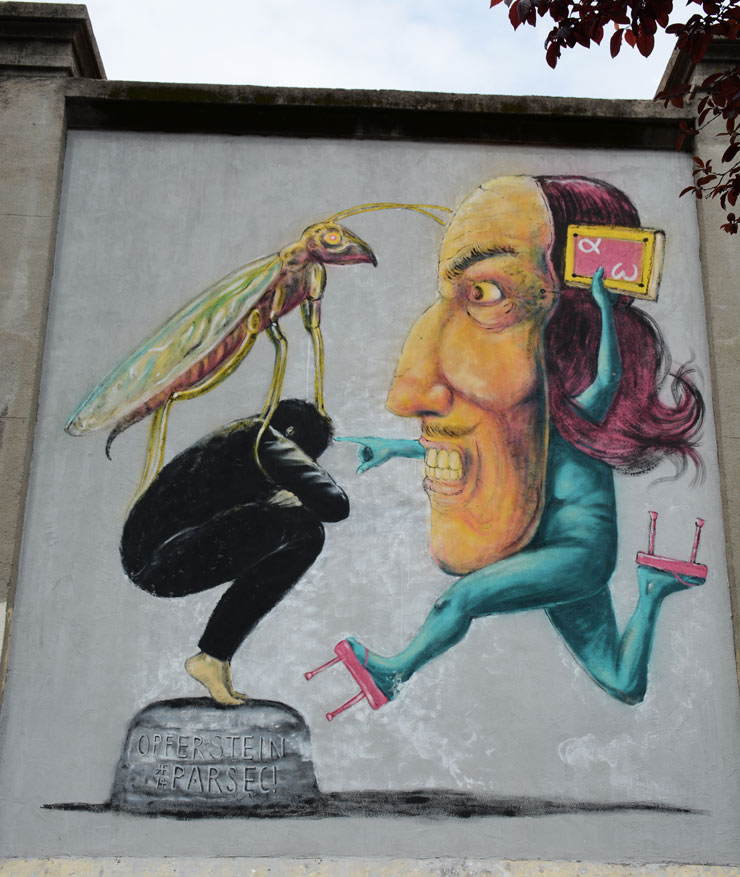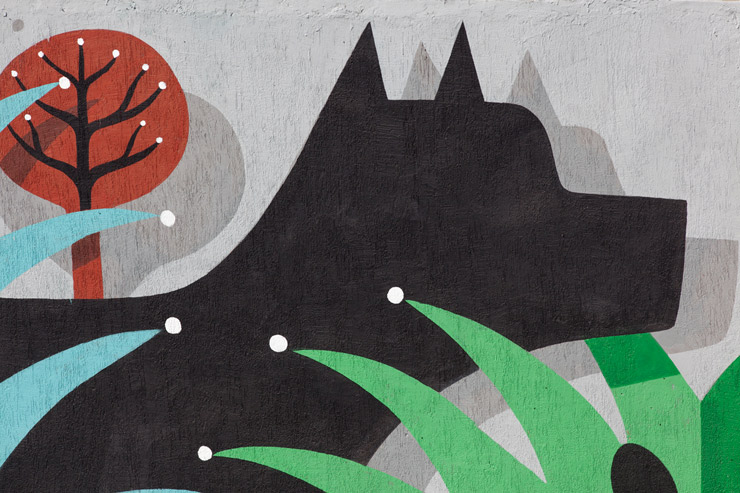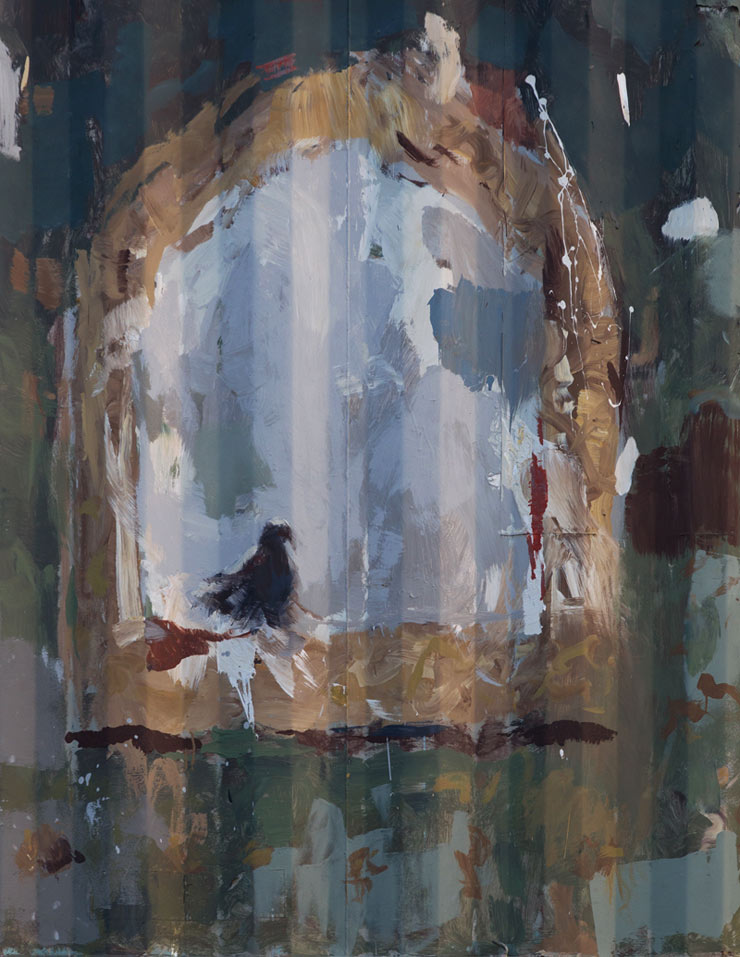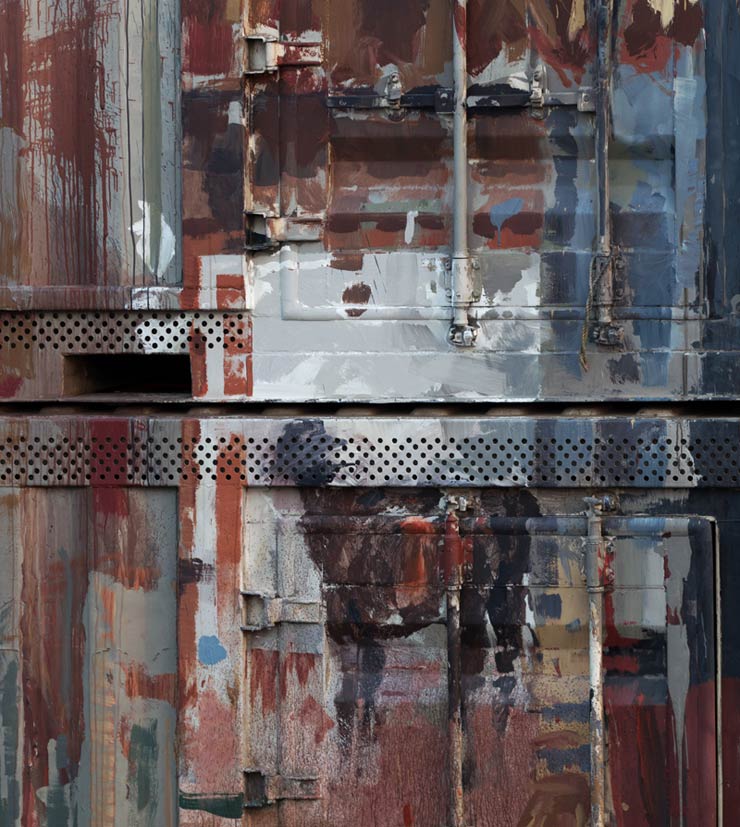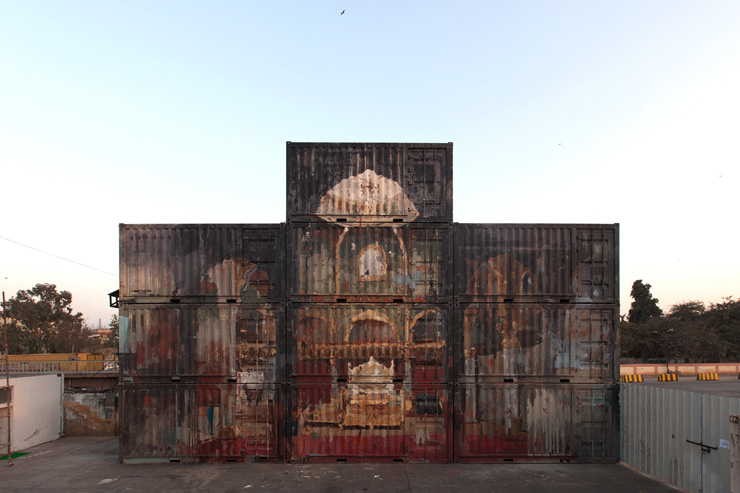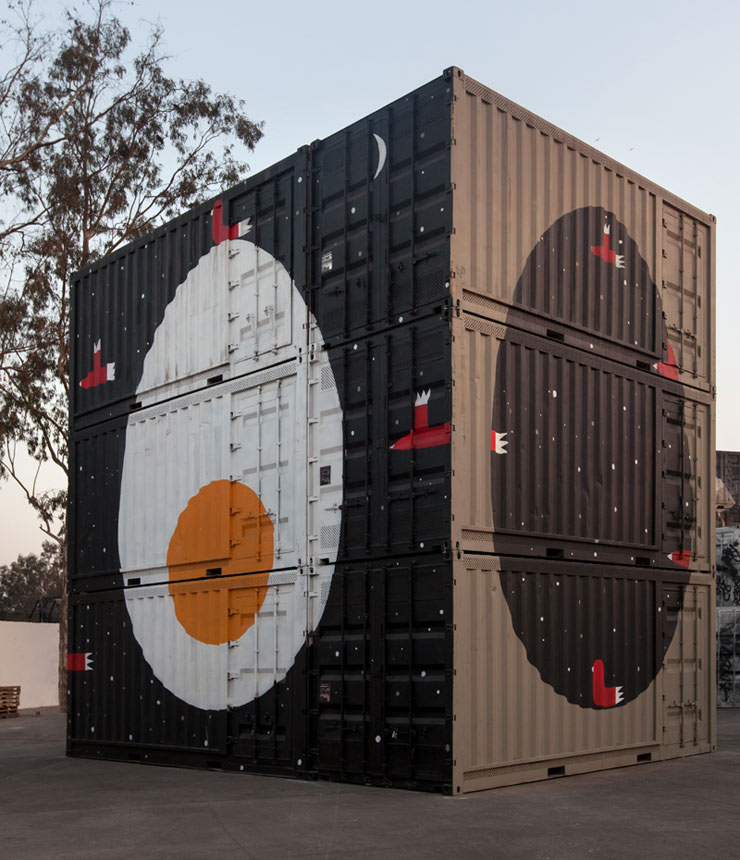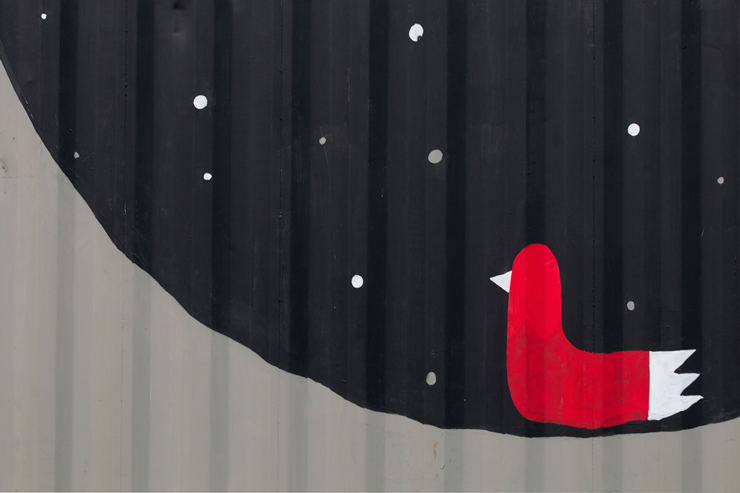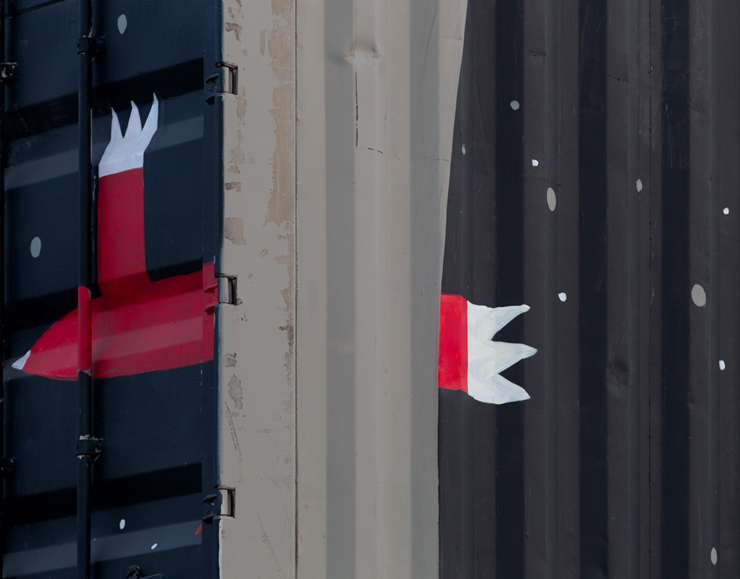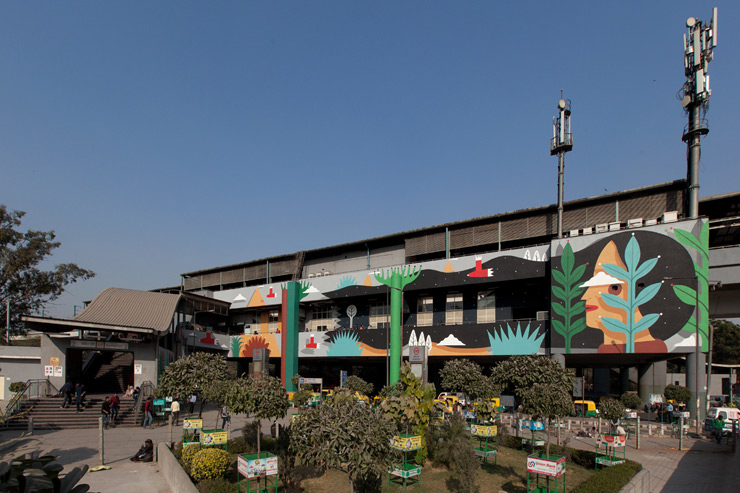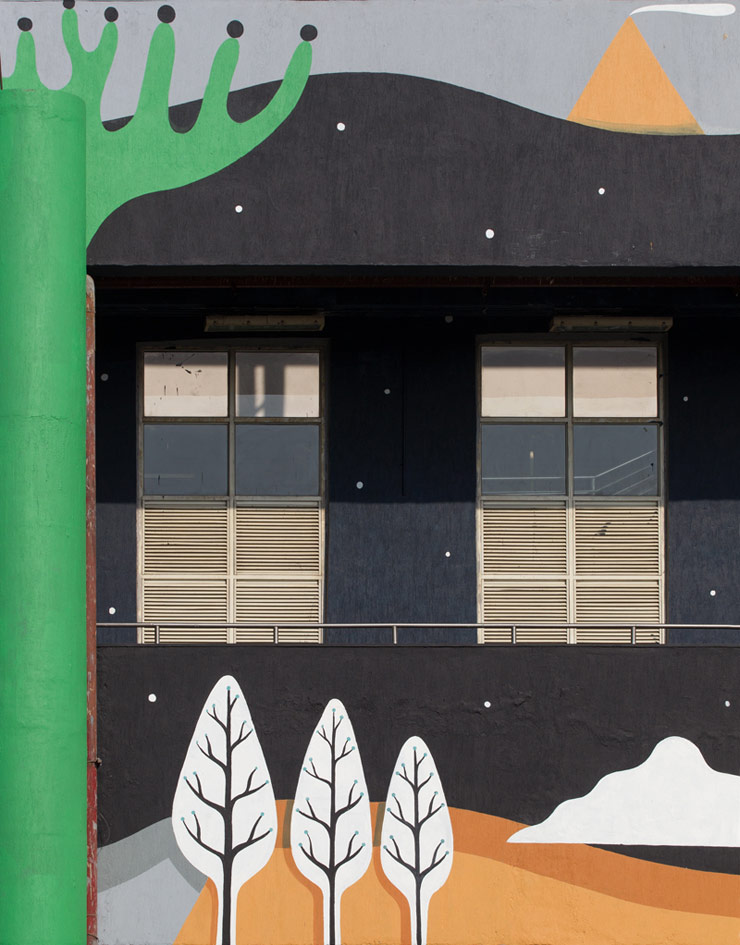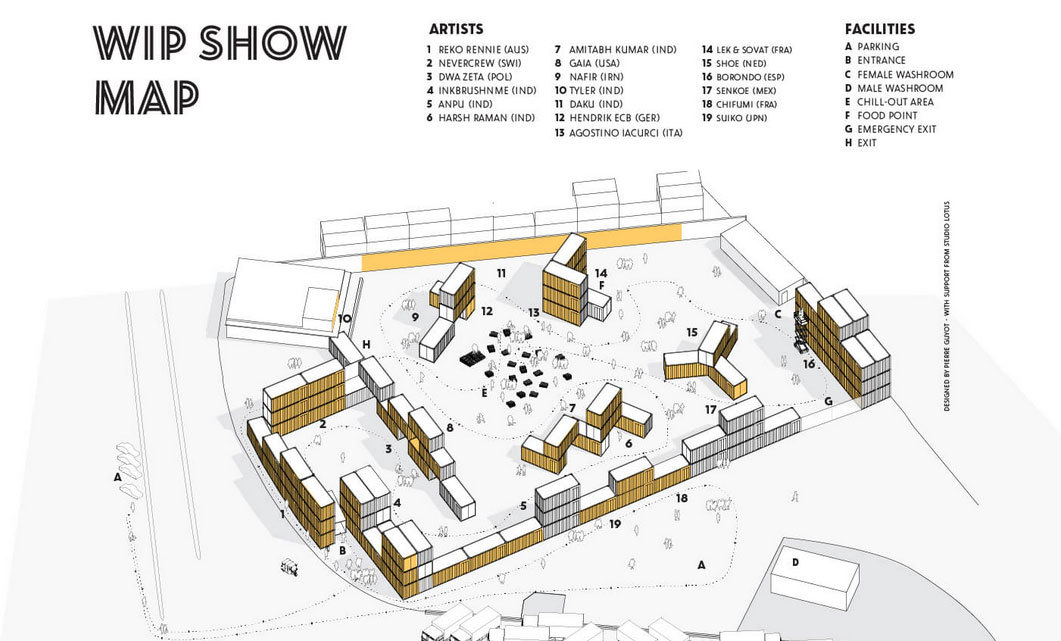A recent mural by Street Artist and fine artist Borondo in the neighborhood of Tegel in Berlin has drawn some attention because of its potentially uncomfortable associations and imagery. Sponsored by Urban Nation as part of their “One Wall” initiative of bringing many large murals to neighborhoods across the city, this one has engaged the ire of at least a portion of the community it appears in.
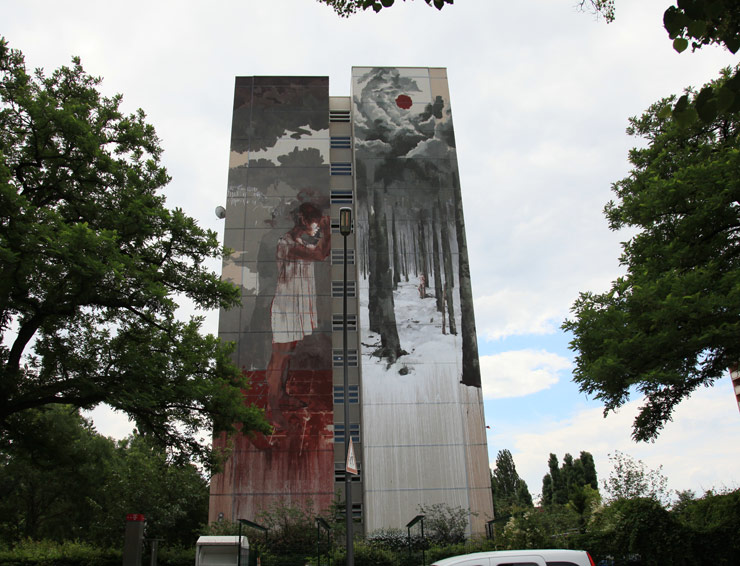
Borondo for Urban Nation this spring (UN) in the Tegel section of Berlin. (photo © Jaime Rojo)
A so-called “controversy” is on media (print, online, and social) radar thanks largely in part to the efforts of one aspiring community leader and candidate for town hall on the center-right CDU ticket, who has rallied neighbors and reached out to the press to protest imagery they say is depressing and frightening because there is red paint that appears to be blood coming from the figure of the girl. The second figure tied to a tree also is a big concern. A new campaign to gather signatures on a petition has begun and accounts in the press say the group would like to find an alternate solution to this mural.
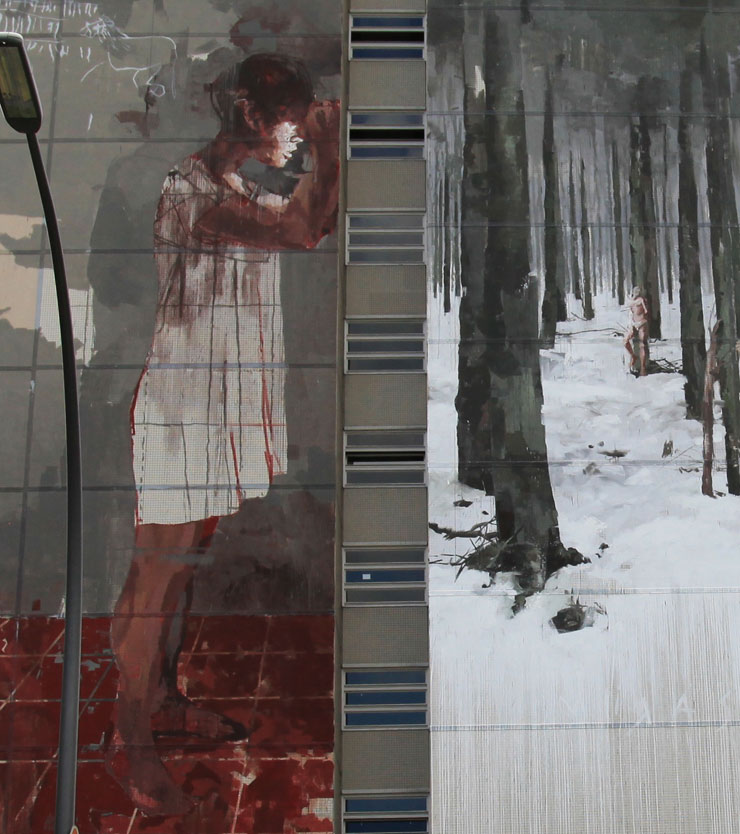
Borondo (photo © Jaime Rojo)
Works of art, of course, will have fans and enemies – as well as people in the middle who have no interest or opinion. This may be a similar situation with the many advertisements on the streets of Berlin featuring images of bare bottoms and breasts that are exalted salaciously from every angle, bearded leather men in carnal embraces, and various action-warriors and criminals and brandishing bloody swords and weaponry.
Berlin, by and large, appears to withstand the thousands of advertising images that undoubtedly challenge the various tastes of its populace. Last year, for example, 200 large Berlin billboards even featured a sex toy by Amorelie with the text “Multiple Orgasmen”, which for you kids and English speakers is translated as “multiple orgasms”. Naturally some racy or violent images, messages, or themes will possibly offend older folks, children, conservative Christians, Jews, Muslims, atheists and immigrants arriving from new countries.

In his personal Facebook page the artist Borondo wrote a lengthy description of his surreal and metaphorical mural called, “Willkommen Refugees” (Welcome Refugees), which he created as Urban Nation’s program PM/9 this spring, curated by Justkids and StreetArtNews. In it he appears to describe the piece as a cautionary tale of looking before leaping, something we always encourage children to do. One of the figures is based on the iconic figure of Saint Sebastian, an early Christian saint and martyr venerated by both Catholic and Orthodox Churches; an interesting figure who is said to have been persecuted for his religious beliefs in Rome in 288 AD and who was comforted by Irene of Rome.
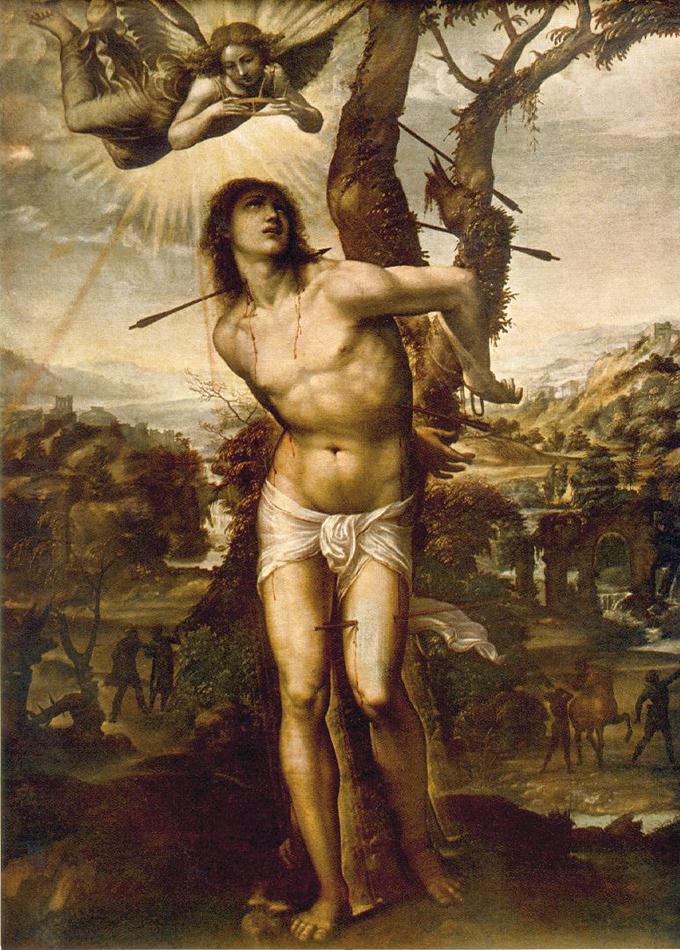
Martyrdom of Saint Sebastian, by Il Sodoma, c. 1525
Saint Sebastian has been depicted in paintings, sculpture, icons, and tattoos as tied to a tree or column, shot full of arrows.
The same image has proven powerful to hundreds of artists through the centuries and has been seen publicly by varied audiences of adults and children in churches, museums, galleries, – and reprised as an archetype for fashion and editorial features in magazines and websites – including a famous one of the boxer Muhammed Ali as a martyr figure similar to Saint Sebastian on the cover of Esquire magazine, which was sold publicly on newsstands.
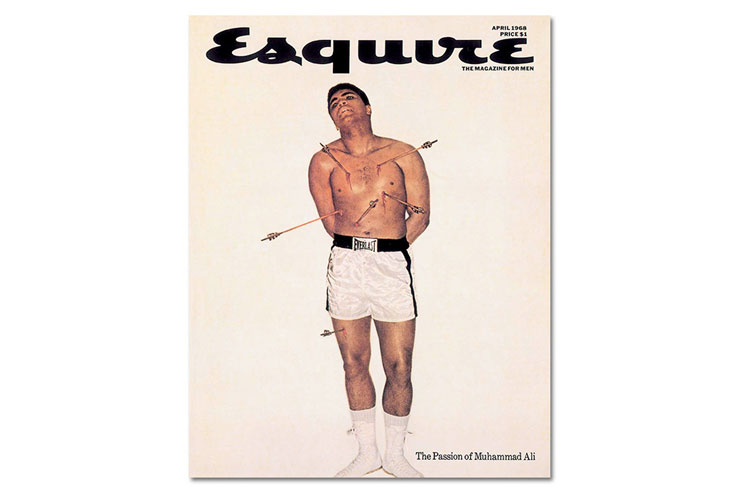
Photographer Carl Fischer’s magazine cover image of Muhammad Ali was directly influenced by Andrea Mantegna’s c.288 painting of Saint Sebastian – with inspiration from art director George Lois, according to High Snobriety.
Borondo says he doesn’t like to impose his own interpretation on his work, which he clarifies is not meant to be just a decoration, and he indicates that he did a fair amount of research into the community, its history, even its weather, when choosing the images and the color palette. But for the sake of continued dialogue, he does break it down for viewers.
“If I explain the work my meaning seems to suggest that there is only one interpretation that is right and all others would be wrong. But sometimes the viewer’s interpretations are more interesting and completely different from the ones I had and I don’t want to close this discourse or exchange.
For me it is a poem composed by images and colors instead of words. I believe that in an art piece it is important to get not an immediate reaction but to promote critical thinking, a research of meanings and different levels of communication.
In this case I wanted to flow on the surface using different image and references to create a sort of big collage realized directly on the 14th floors high wall.
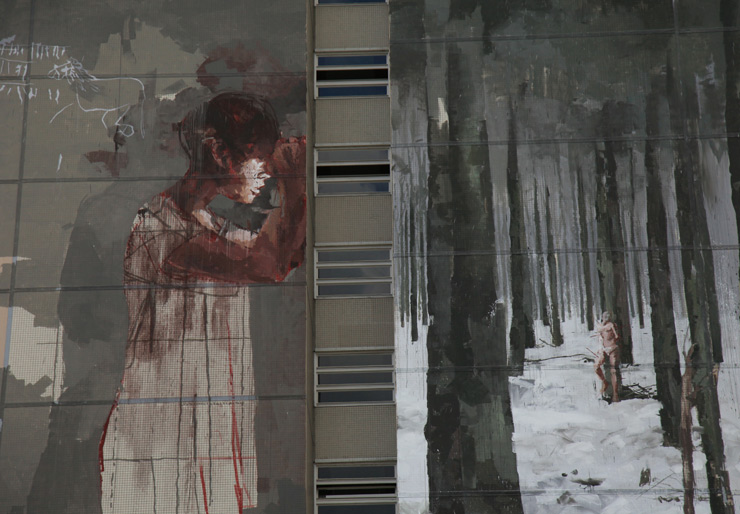
Borondo (photo © Jaime Rojo)
The wall is divided in two sides with a gap of windows in the centre so I used this gap to represent a wall that creates a double dimension. On the left side there’s a figure looking through a hole, while the right side depicts St. Sebastian inspired by Renaissance paintings inserted in a snow forest with a cloud accumulation on top. The “wall” represents a division, a frontier and in this case creates a distance: outside the drama and inside an empty room with a small hole from which one can see the reality. A reality that we may pretend to not see but we need to be curious about – as the child depicted here – to know and understand.”
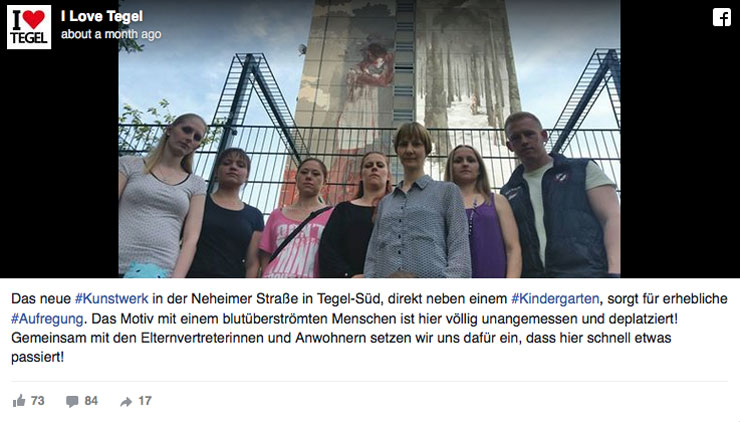
Not everyone is convinced by Borondo’s description of his work, and some are particularly sure that children and emotionally scarred adults who go to a nearby therapy center will be very negatively impacted. Additionally there is a sentiment that the artwork is an imposition on daily life. A user on Facebook named
“You forgot to mention, that there is a daycare for children between 1 to 6 years old next to this building and on the other side a house, which is known as the suicidehouse.
I understand what you want to tell us, but it won’t help me or other parents to explain this to our little children every day, we have to walk there. And for the Refugees, who will come there to the end of the year … I don’t know, but if I would have seen what they have seen, I would want to see something different at a place, which will be my new home in safety … no reminder every day of a horrible past.
The real Problem I see here, even if I know the picture by now, I have no chance, not to look at it every morning and evening, when I cross the Street there. Art is good and needed, but I want to decide by myself, if I want to see it or not and here you force me to look at it and that is — for me — no art anymore.”
Online and on TV, Felix Schönebeck has been at the front of the protest against the mural and he is also running as one of the youngest candidates for the CDU this September. Mr. Schönebeck is not quoted mentioning Saint Sebastian or Borondo much when he is standing before the cameras of various news stations that come to Tegel to see him and the mural. Similarly, many of the media reports don’t mention the artist or his explanation of his work. It does appear that Schönebeck has analyzed the art and has concluded that the artist has created an affront to the community.
This Borondo wall is 4th in a series of murals begun last year for the residents by some pretty famous Street Art names that include a duo named The London Police, the German twin brothers How & Nosm, and a collaboration with Collin Van Der Sluijs and Super A. Until this new Borondo mural went up this spring, Schönebeck and the community have given the other murals good marks. What is a little unclear is why these other murals have escaped criticism and threats of public petitions and media campaigns. That is perhaps one of the ironies of art – it can be very subjective.
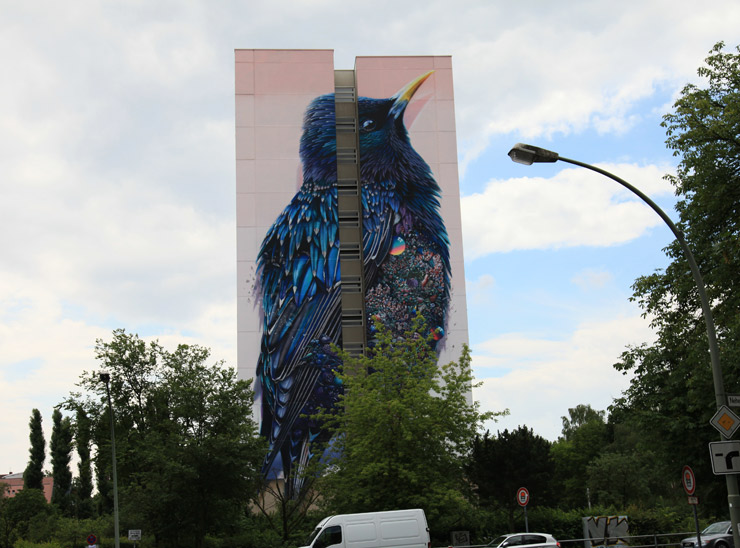
Collin Van Der Sluijs and Super A created this mural just to the right of Borondo’s for Urban Nation this spring (UN) in Tegel. (photo © Jaime Rojo)
The English Art critic Clive Bell was an advocate of formalism but his intellect also clearly recognized that our experience of art is often skewed through that other less measured and quantified quality, our emotions. In an essay from his book entitled “Art” just over a hundred years ago, Bell wrote, “The starting-point for all systems of aesthetics must be the personal experience of a peculiar emotion. The objects that provoke this emotion we call works of art. All sensitive people agree that there is a peculiar emotion provoked by works of art.”
With this in mind, it may be that the emotional response to these artists painting styles has revealed how different audiences are affected by them, because at least two of the three other murals here contain elements, that is “content” in modern Internet parlance, that could prove equally objectionable to certain viewers. However political candidates and community residents have given some paintings high marks possibly because of the artist’s particular aesthetics.
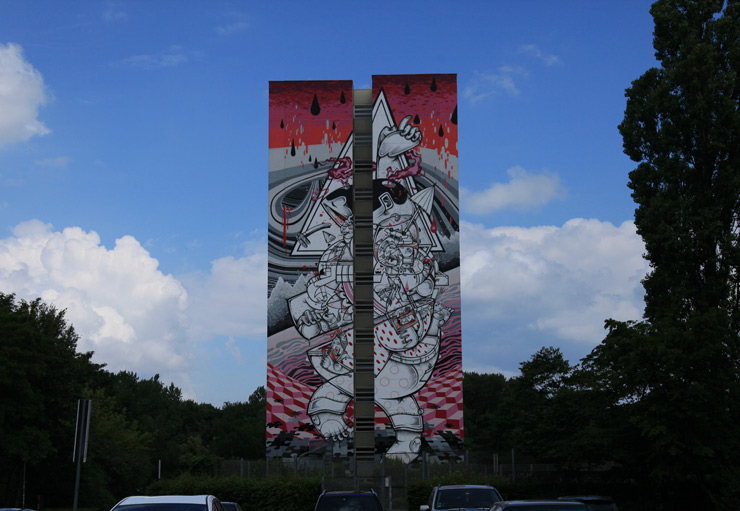
German twins How & Nosm created this mural in the same housing complex Borondo’s for Urban Nation last summer (UN) in Tegel. (photo © Jaime Rojo)
Installed for a year, the How & Nosm piece “On Tip Toes” has gone without negative comment from politicians or community members, despite what may appear to some as a composition showing a figure cut in half, bisected. There is a heavy use of the color red in their work that also could be seen as dripping or gushing blood in the various symbolic scenes that play out across the wall. Perhaps it is a matter of personal taste that this wall has been embraced to some degree – as the brother’s work contains more clearly defined, energetic geometric shapes and rhythms, emulating styles more often associated with comics, cartoons, or graphic novels.
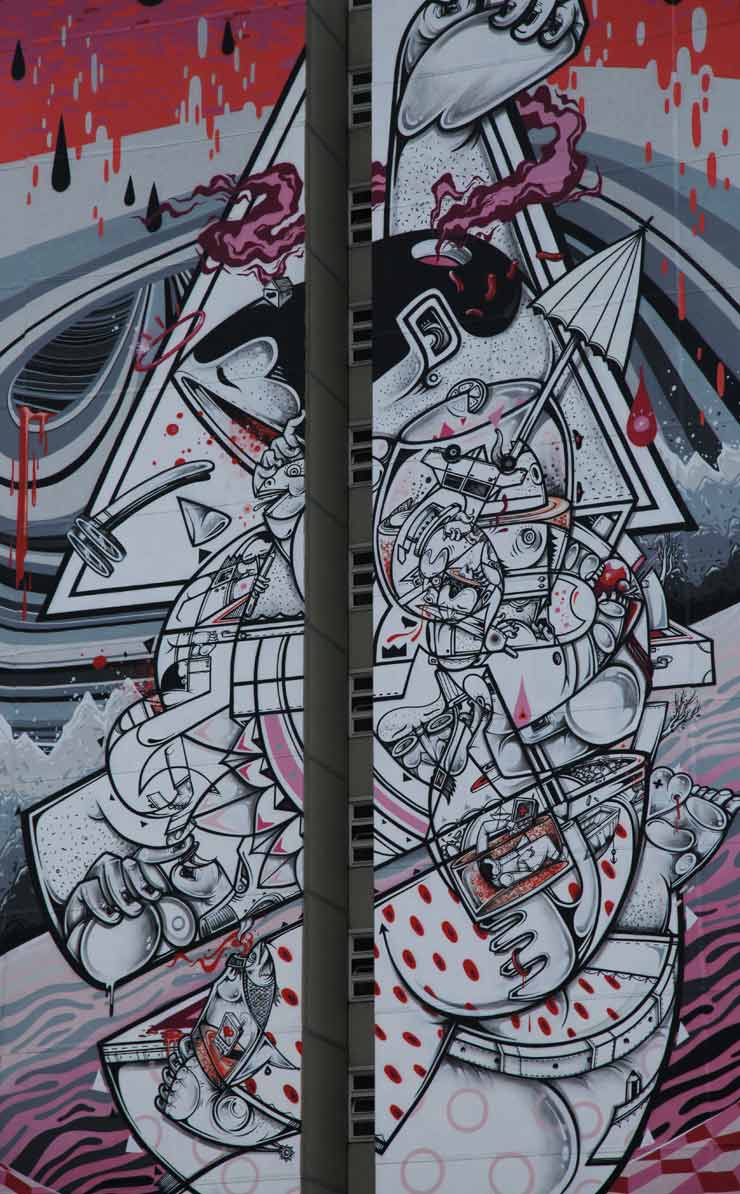
German twins How & Nosm created this mural in the same housing complex Borondo’s for Urban Nation last summer (UN) in Tegel. (photo © Jaime Rojo)
The themes inside the illustrative forms and figures are less obvious than Borondo’s mural but How & Nosm’s work has been described in the past as including complex motifs that often address topics such as drug abuse, fraud or oppression and they personally have described many dark themes that draw from their own challenging biography in interviews.
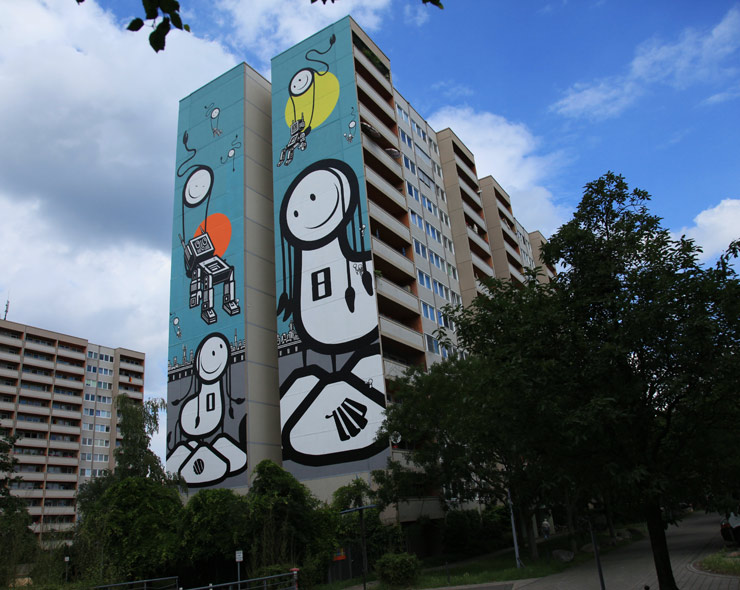
The London Police created this mural in the same housing complex on the opposite end of Borondo’s building for Urban Nation (UN) in Tegel. (photo © Jaime Rojo)
There has also been a surprising lack of commentary regarding the otherworldly scenario depicted 42 meters high by The London Police in the housing complex – at the exact end of the building that Borondo’s mural is on. Enormous sperm-like smiley faces float in the toxic green sky, gently delivering dead or nearly unconscious robot figures down on top of a Berlin cityscape. This imagery also could prove nightmarishly scary to children who can see it very clearly from the nearby playground, yet, no public campaign has arisen to protest it.
We exaggerated the description of that mural, but for illustrative purposes. One can see, as most people do, that art is purely subjective and has always been. Contemplating the inexact and sometimes murky quality of an artists’ expression may be frightening to some viewers, reassuring and encouraging to others.

On the day we went to see this contested mural we saw perhaps of handful of people on a typical weekday walking by it, including an older couple who stopped to snap a photo of the mural as well as the Collin Van Der Sluijs and Super A collaboration next to it of a multi-hued bird. Neither seemed particularly unnerved but were pleasantly pointing to areas of it and discussing it – which rather seems to be to point of public art. They walked further up the sidewalk, albeit slowly. We also saw a few kids riding bicycles past, and a family of father, mother and two kids get into a car parked across the street from it. It was not evident superficially that the mural had impacted them, but of course we are not social scientists. We did notice that the sky was grey and cloudy, and the atmospheric quality of Borondo’s piece rather blended directly into it.
Full disclosure, we have worked with Urban Nation as curators of art and artists, most recently for our “Persons of Interest” show in the nascent UN museum space for a show the Spring of 2015, so we are familiar with at least that part of the organization and it’s director, Yasha Young. From an intellectual perspective on how our show was handled by UN, we can say that our 12 Brooklyn-based artists delved deeply into the cultural and social history of Berlin as well as Brooklyn, and UN stood behind some of the more challenging themes addressed directly or indirectly by artists such as religious freedom, the wearing of headscarves, feminist empowerment, immigration, African-German identity, GLBT issues, racism, corruption, the damaging effect of drugs and alcohol, celebrity culture, and depression.
As ever, one can also see the value of seeking and finding a balance with art and the community. Naturally, dialogue can be intrinsic to the success of large-scale mural projects. It will be interesting to see how the future of Borondo’s “Willkommen Refugees” plays out but we’re guessing that more discussion about the piece, its authors intentions, and the community’s opinion will be better than less.
I Love Tegel site http://ilovetegel.de/category/allgemein/
Schönebeck’s FB page https://www.facebook.com/felix.schoenebeck
BSA<<<>>>BSA<<<>>> BSA<<<>>>BSA<<<>>> BSA<<<>>>BSA<<<>>>
Please note: All content including images and text are © BrooklynStreetArt.com, unless otherwise noted. We like sharing BSA content for non-commercial purposes as long as you credit the photographer(s) and BSA, include a link to the original article URL and do not remove the photographer’s name from the .jpg file. Otherwise, please refrain from re-posting. Thanks!
BSA<<<>>>BSA<<<>>> BSA<<<>>>BSA<<<>>> BSA<<<>>>BSA<<<>>>
This article is also published on The Huffington Post
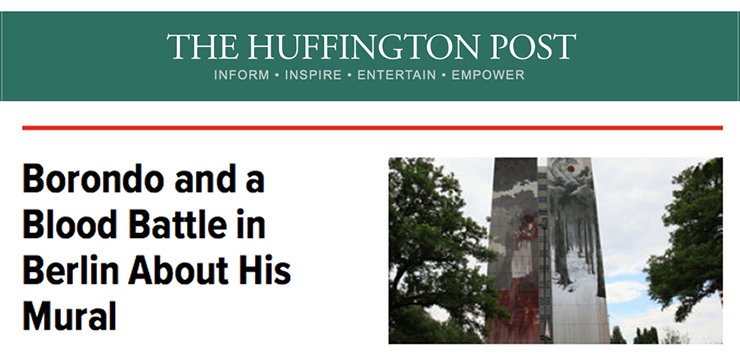
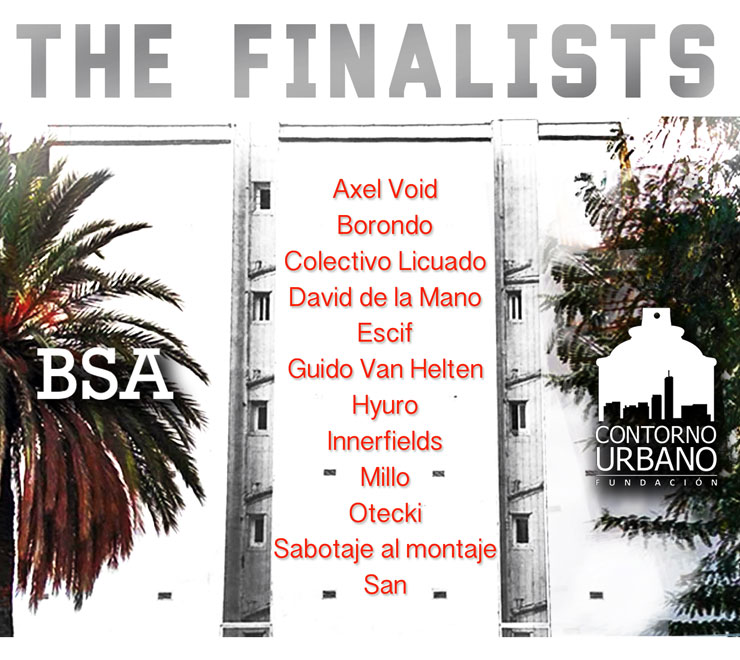
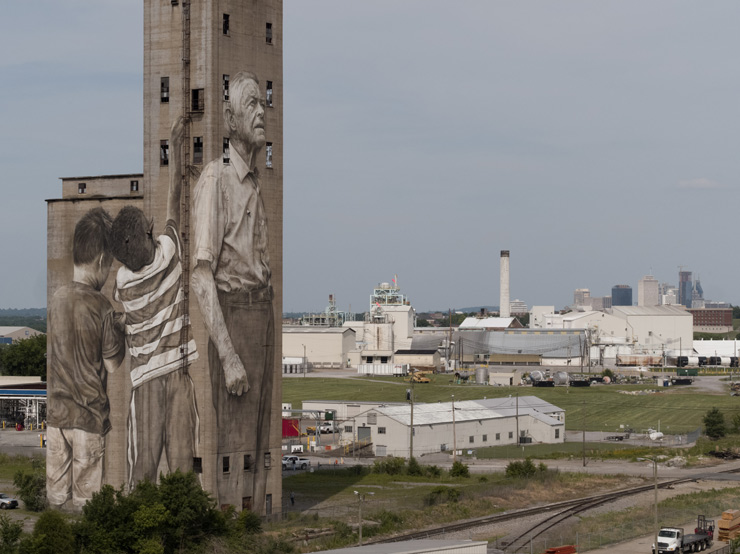

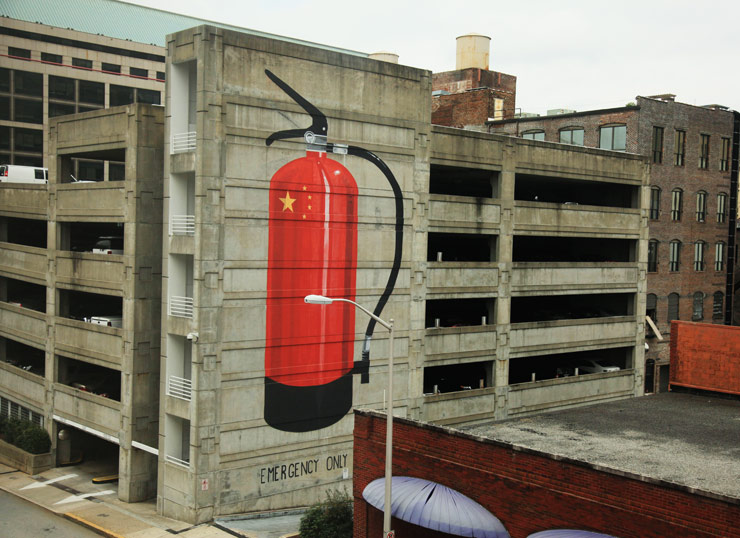
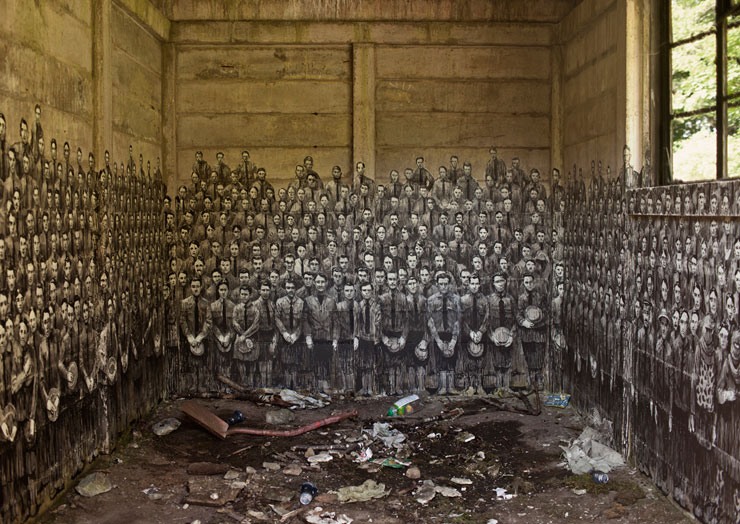
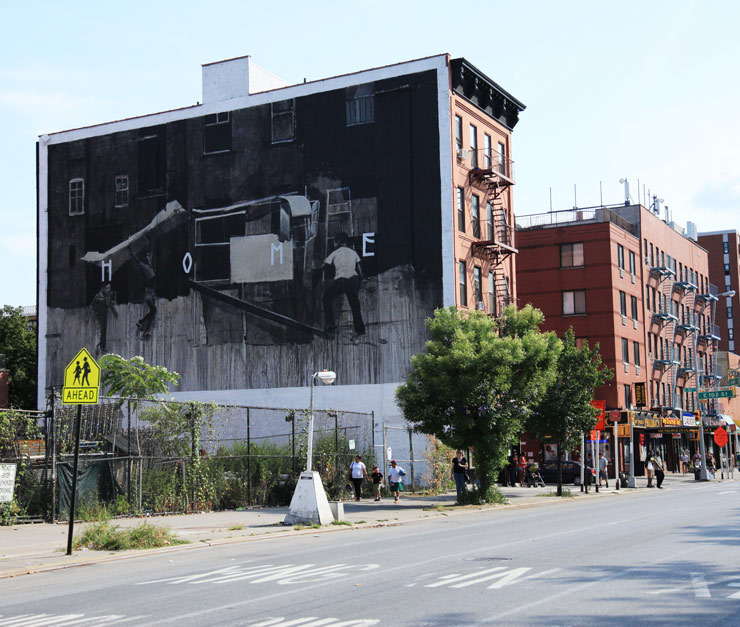
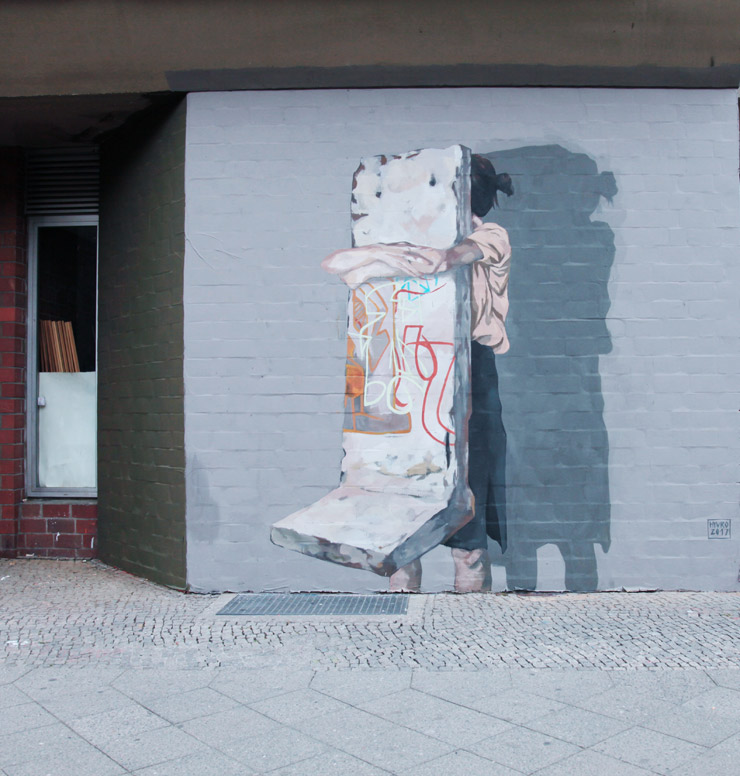
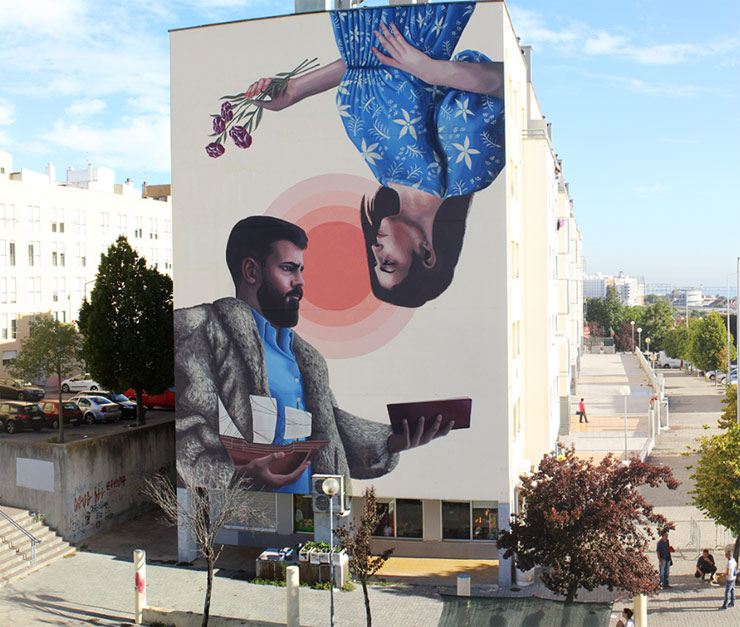

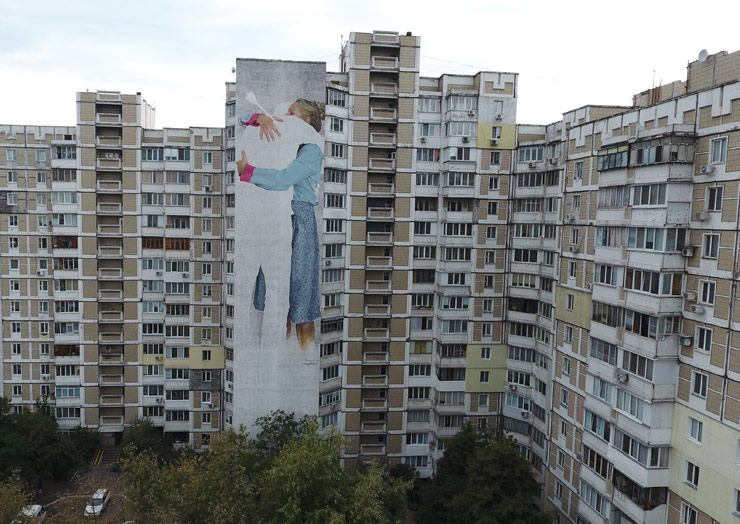
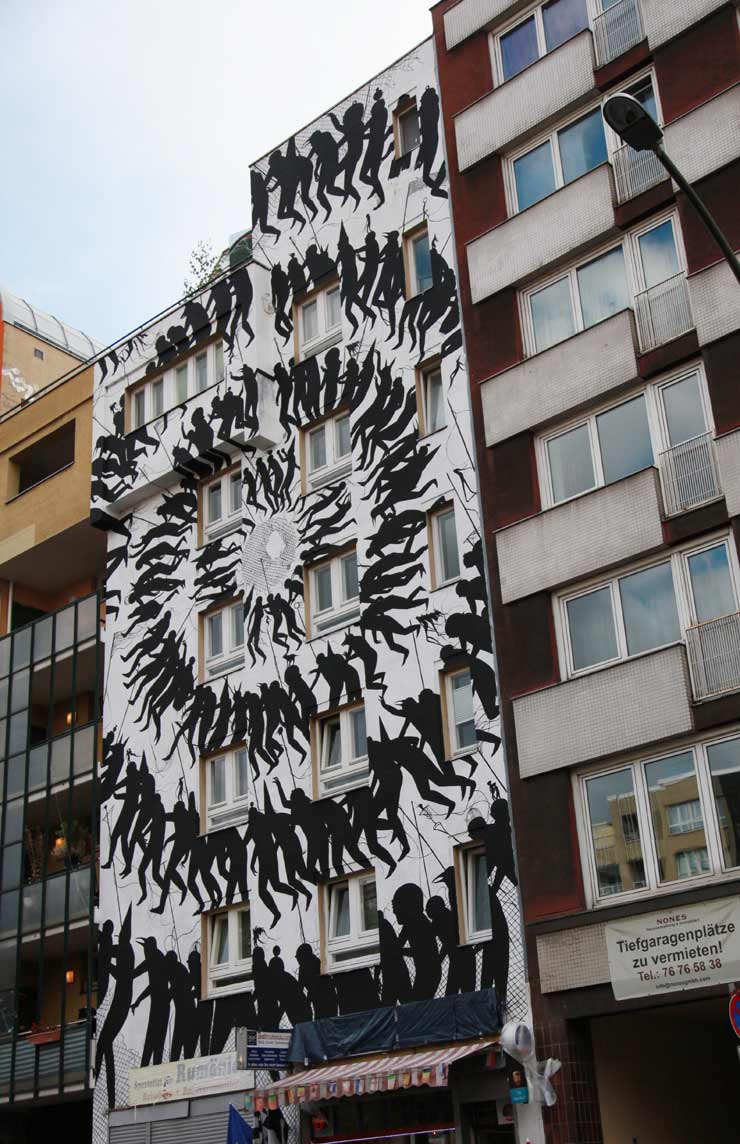
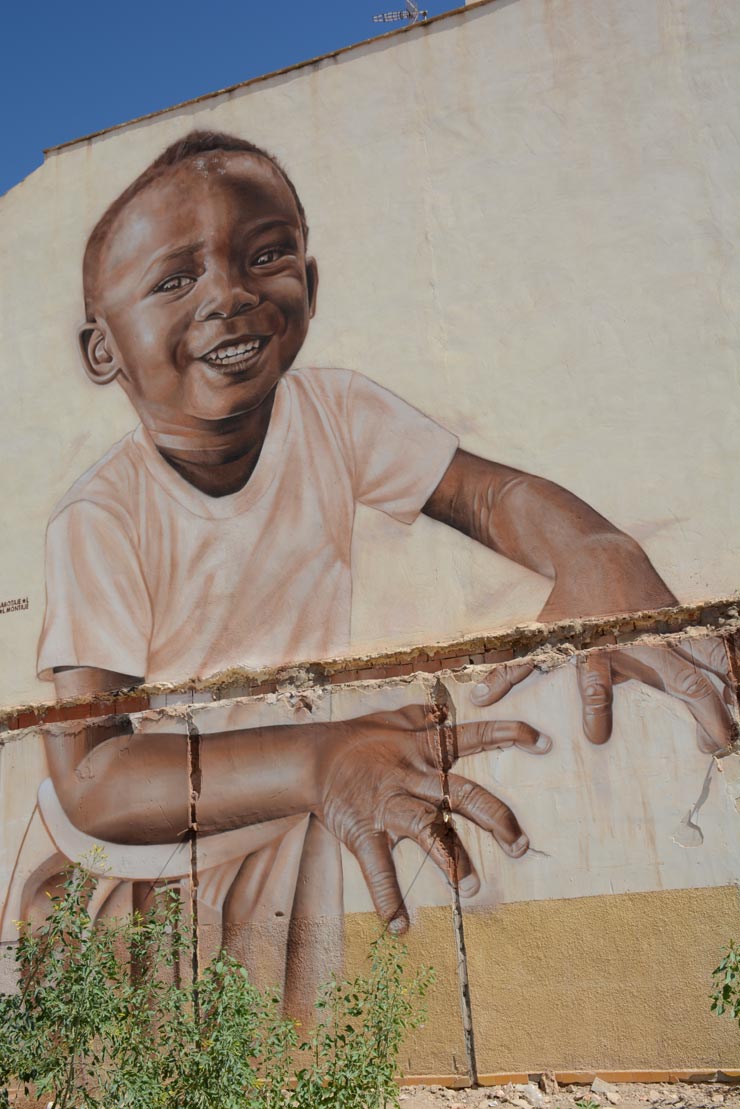
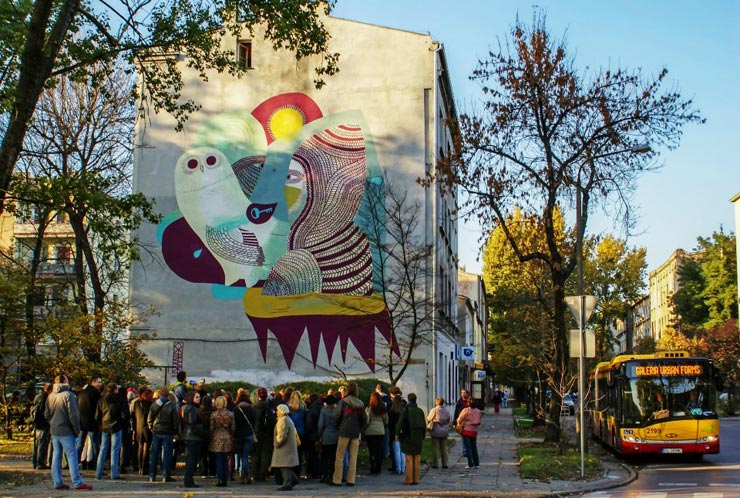
 BROOKLYN STREET ART LOVES YOU MORE EVERY DAY
BROOKLYN STREET ART LOVES YOU MORE EVERY DAY